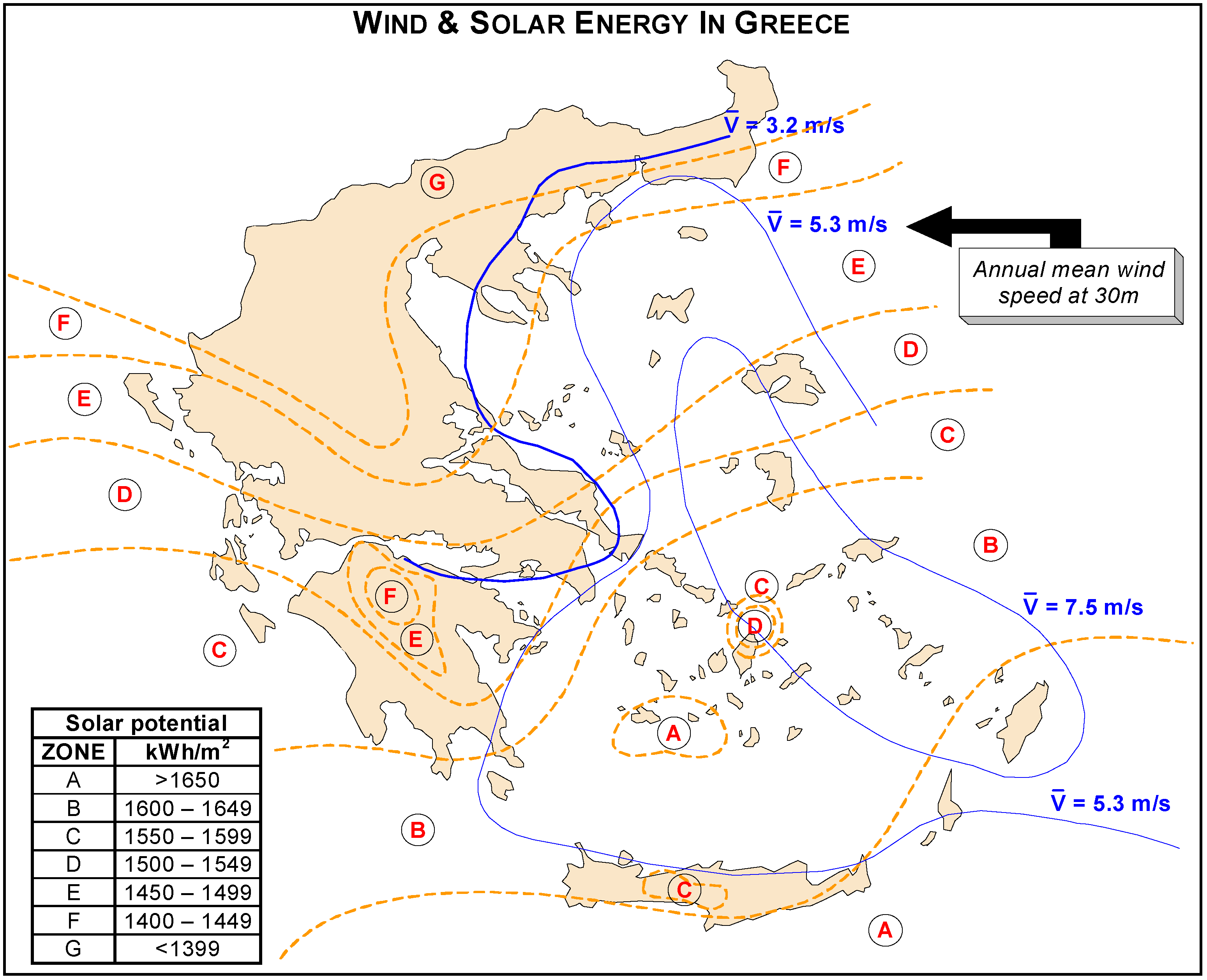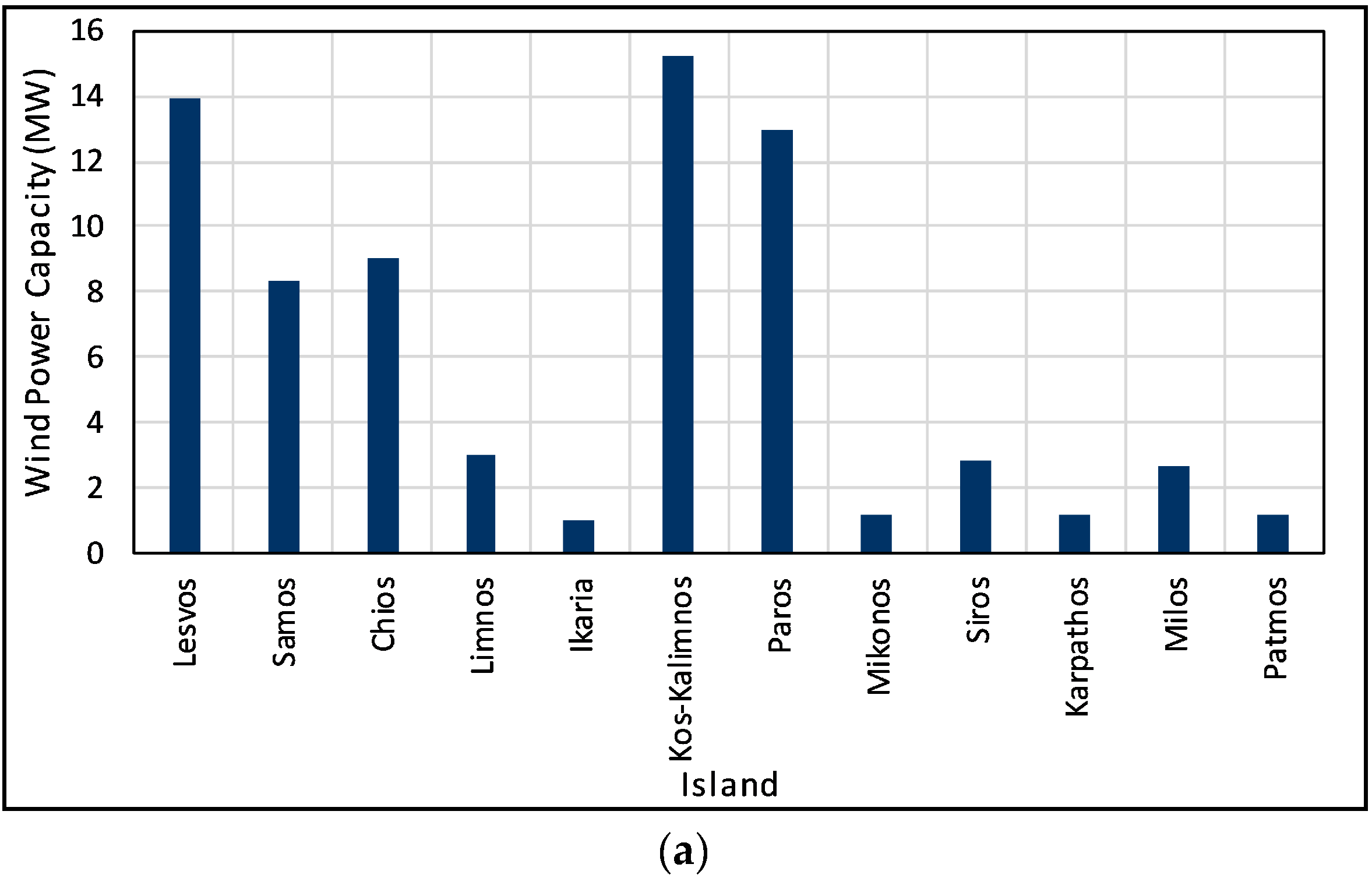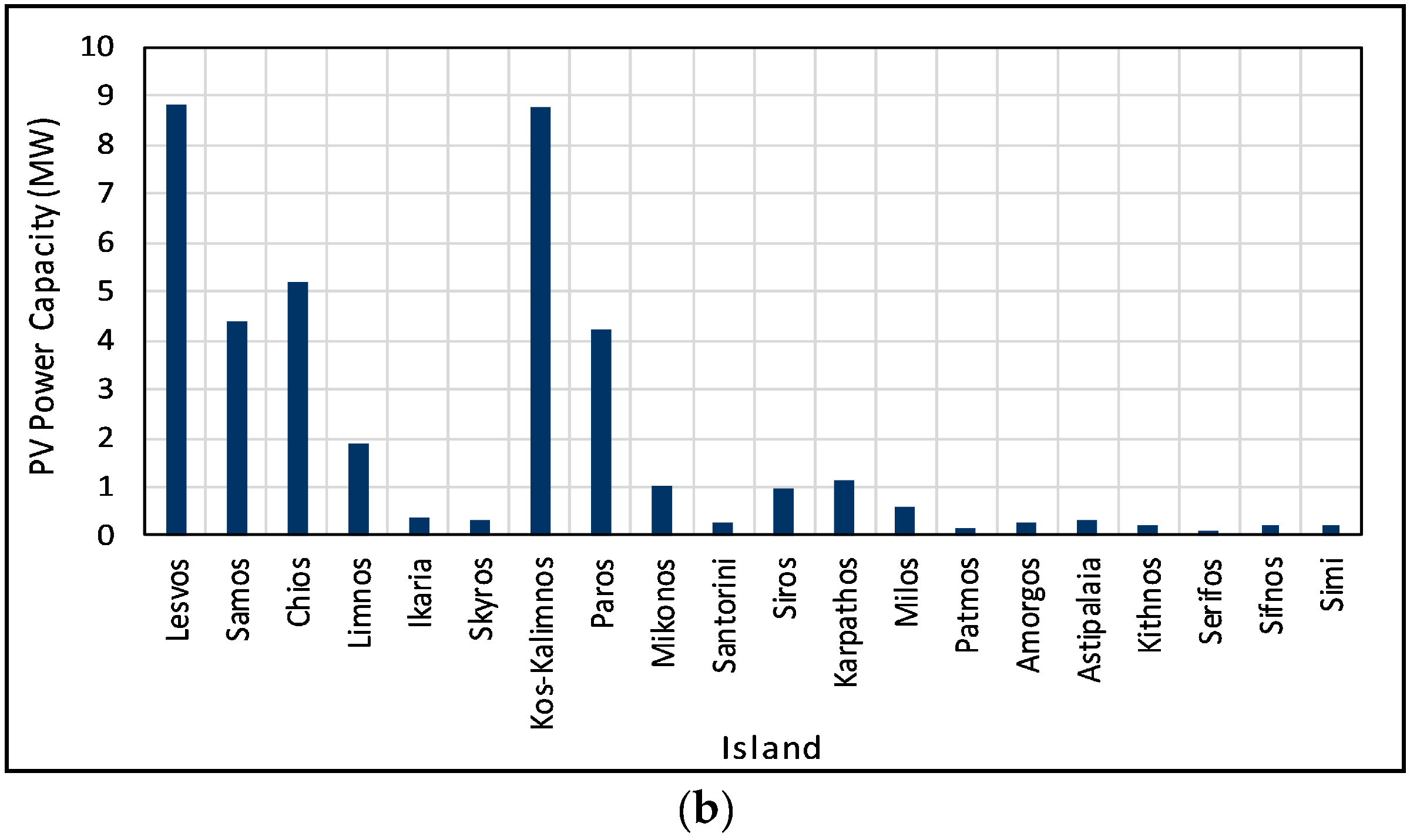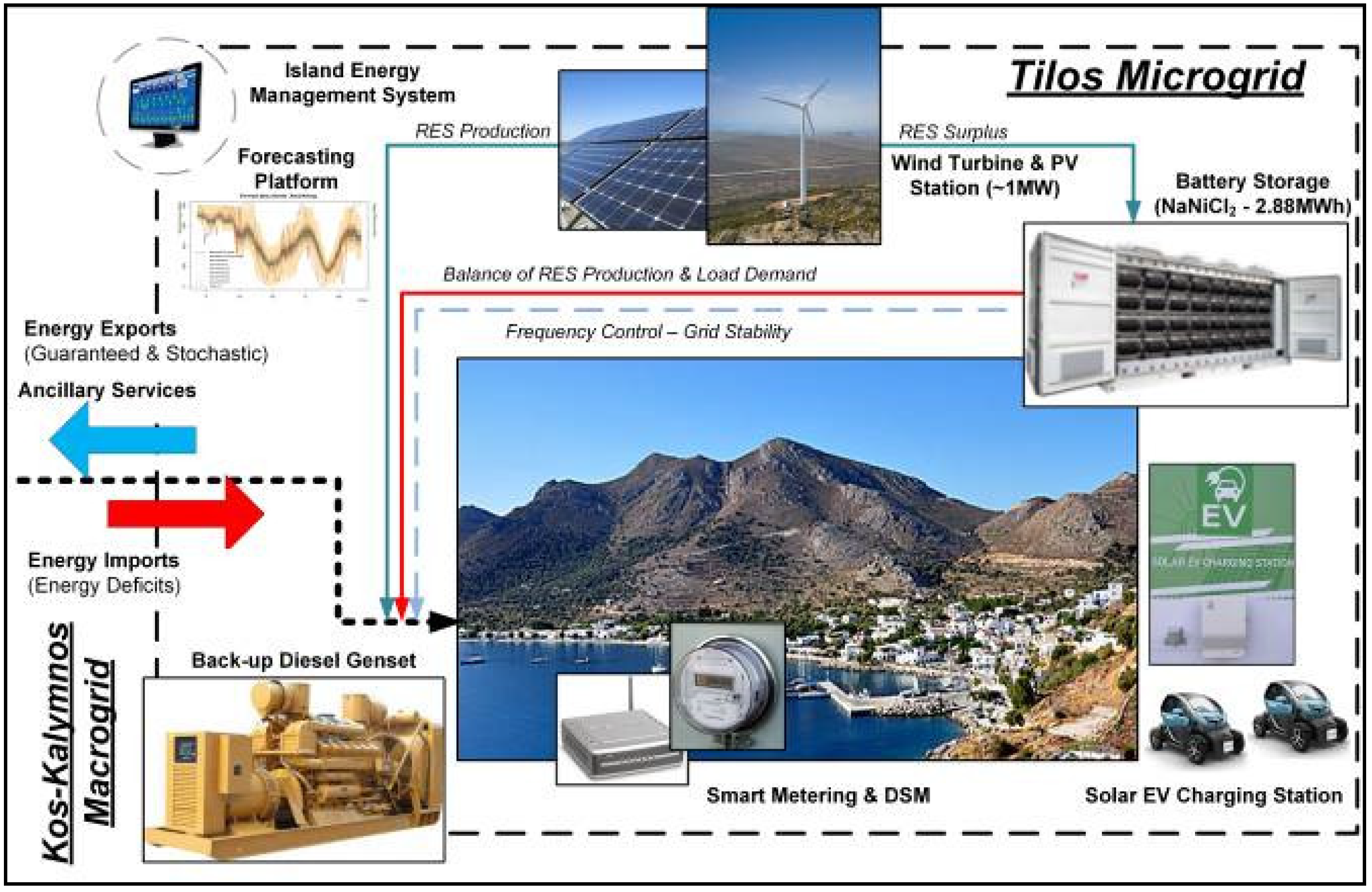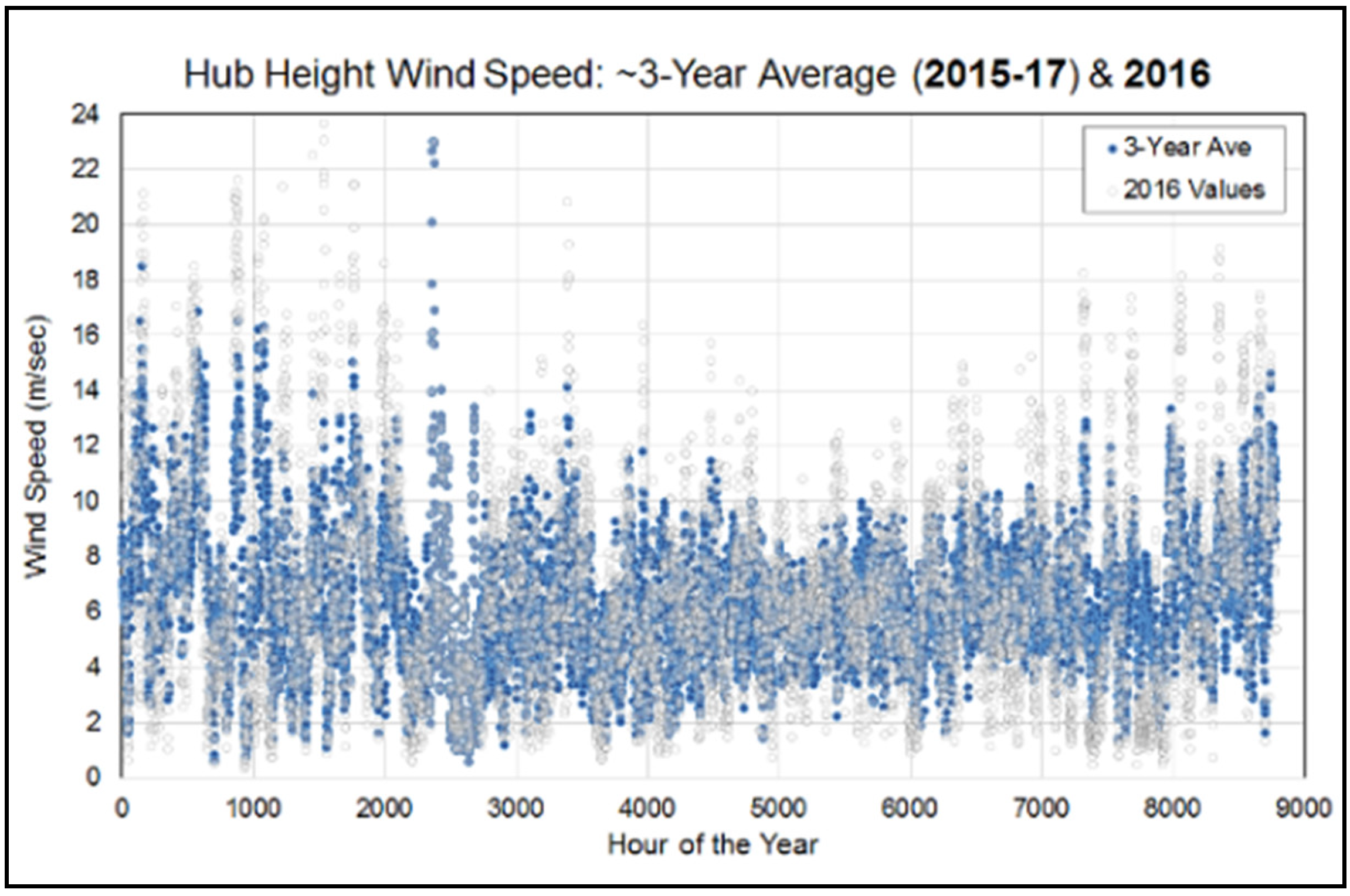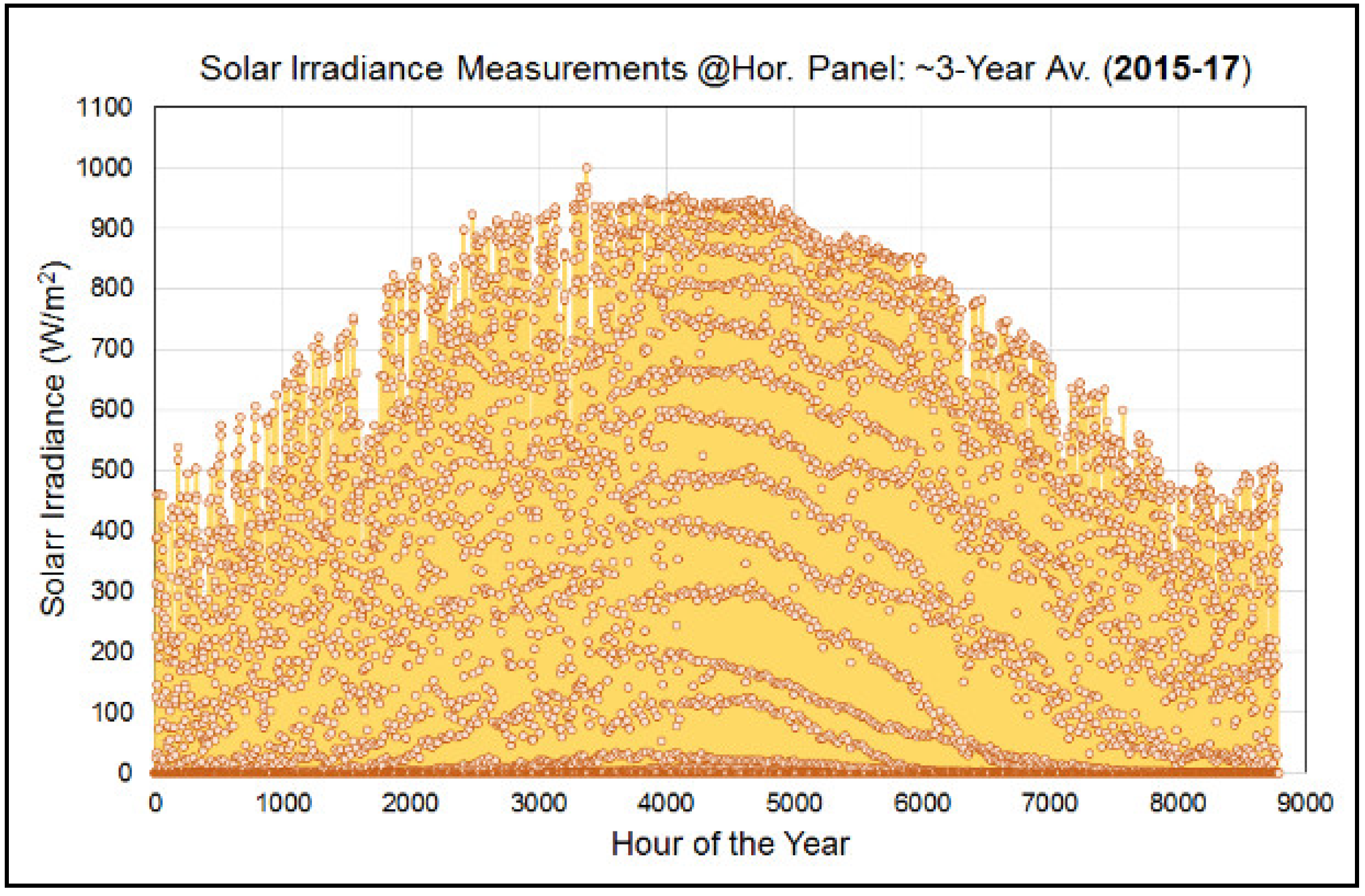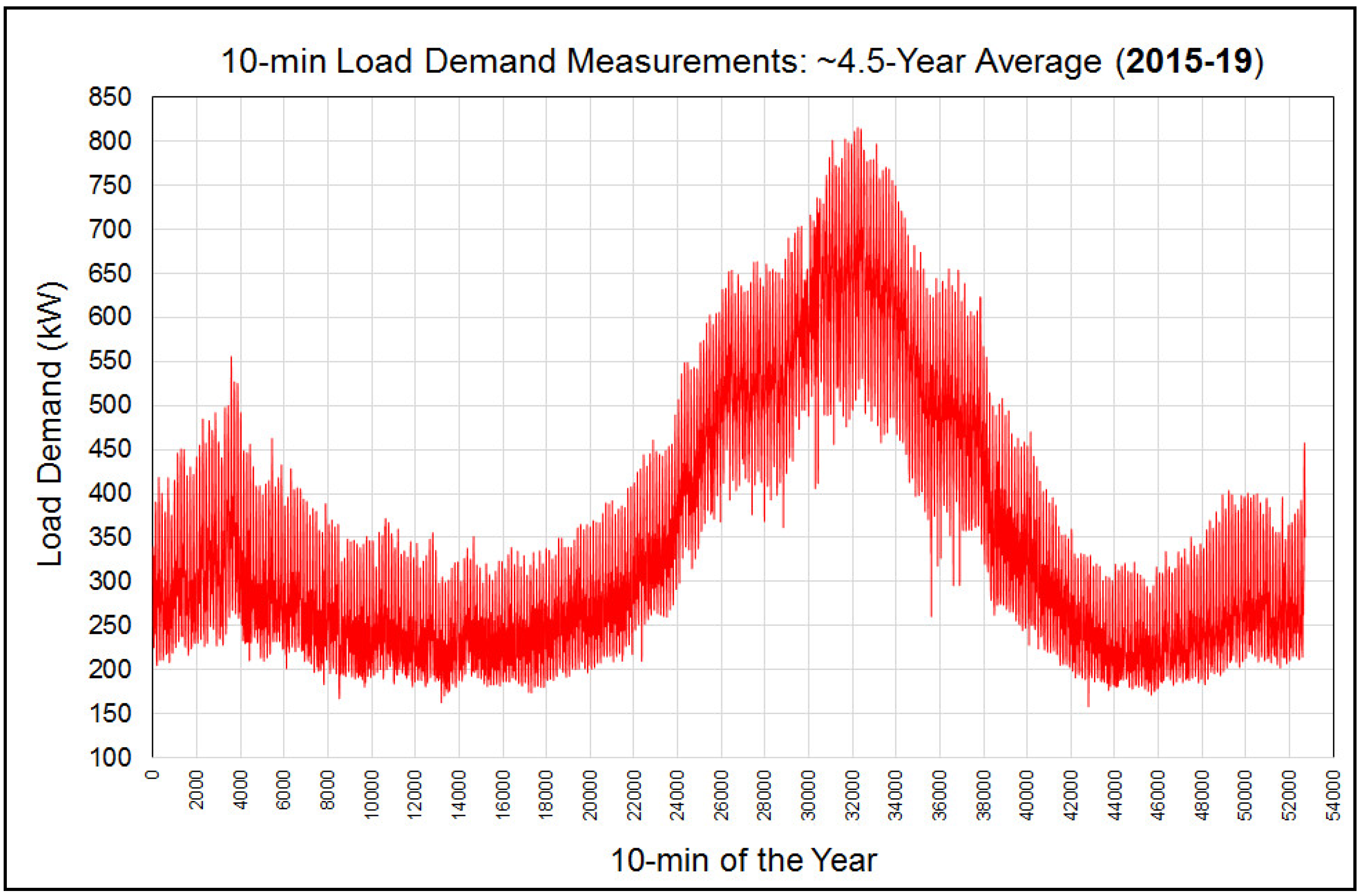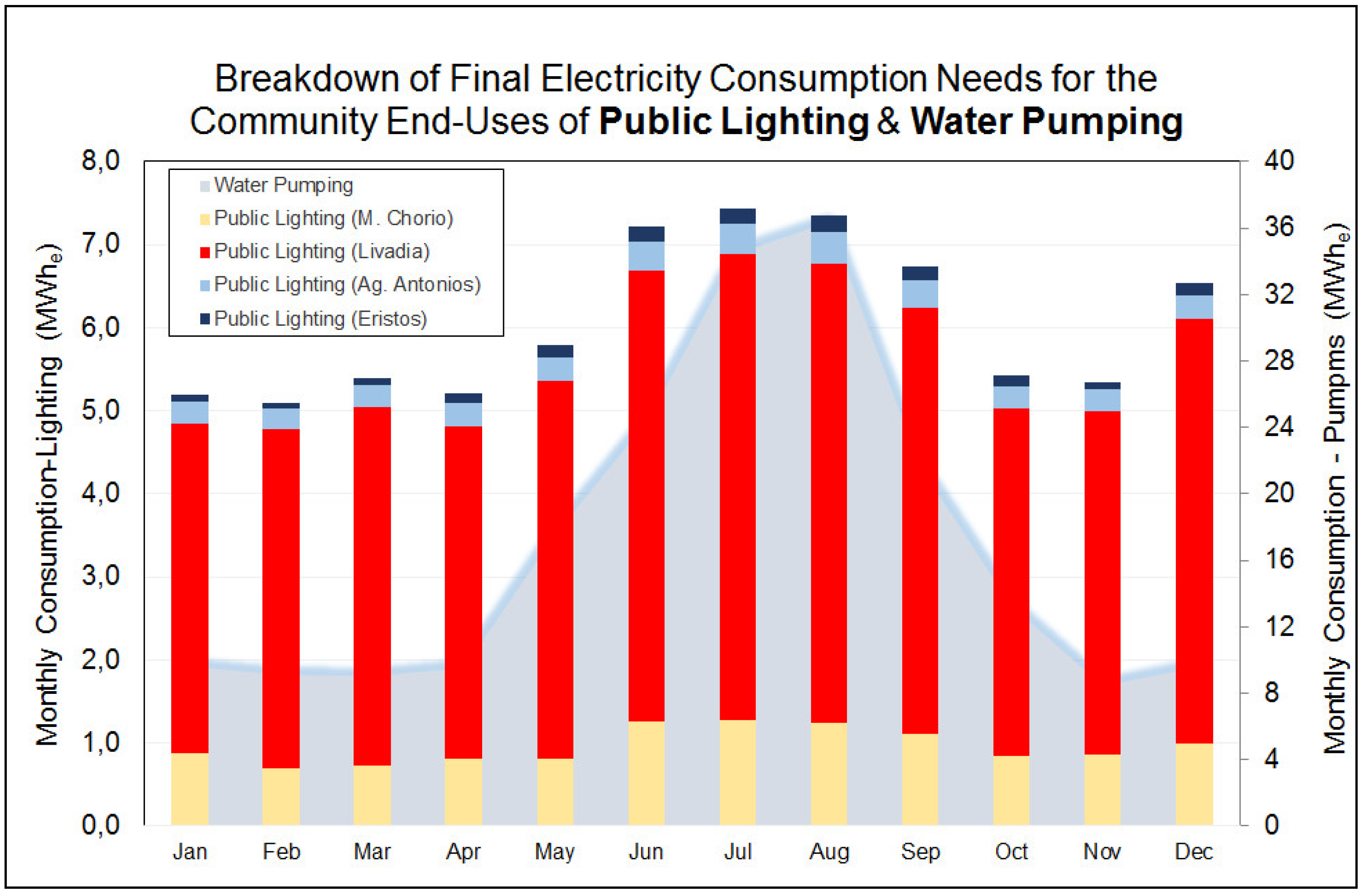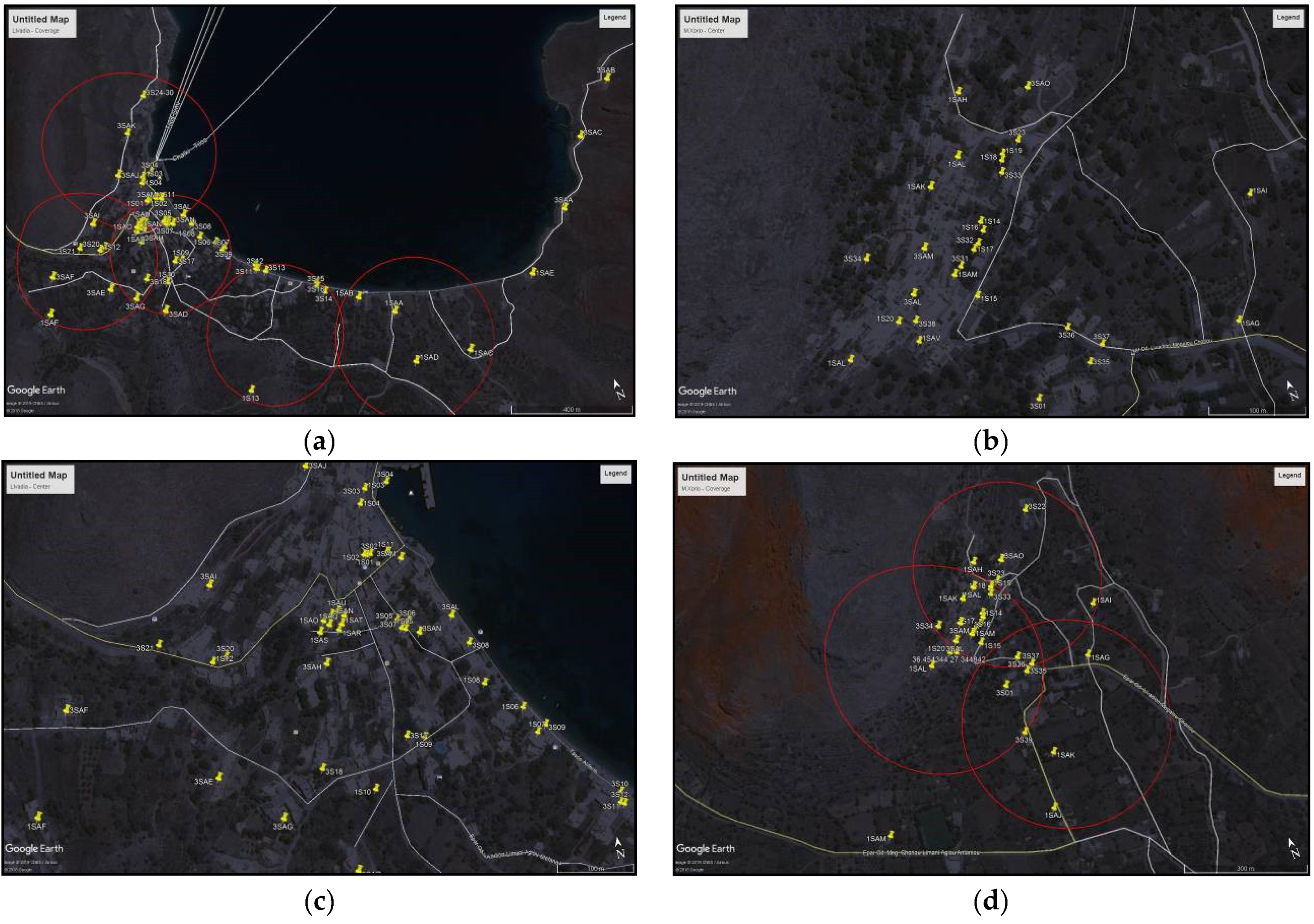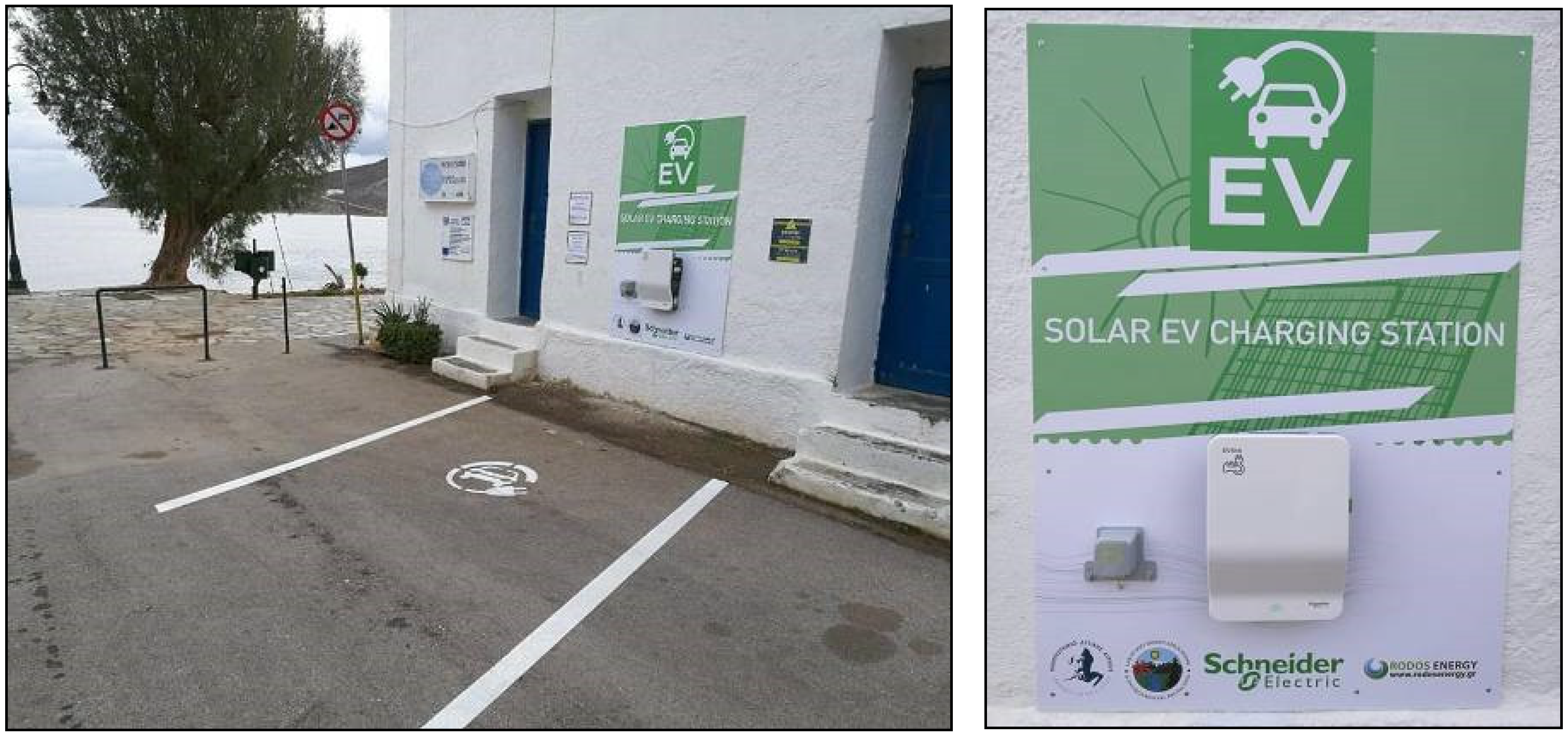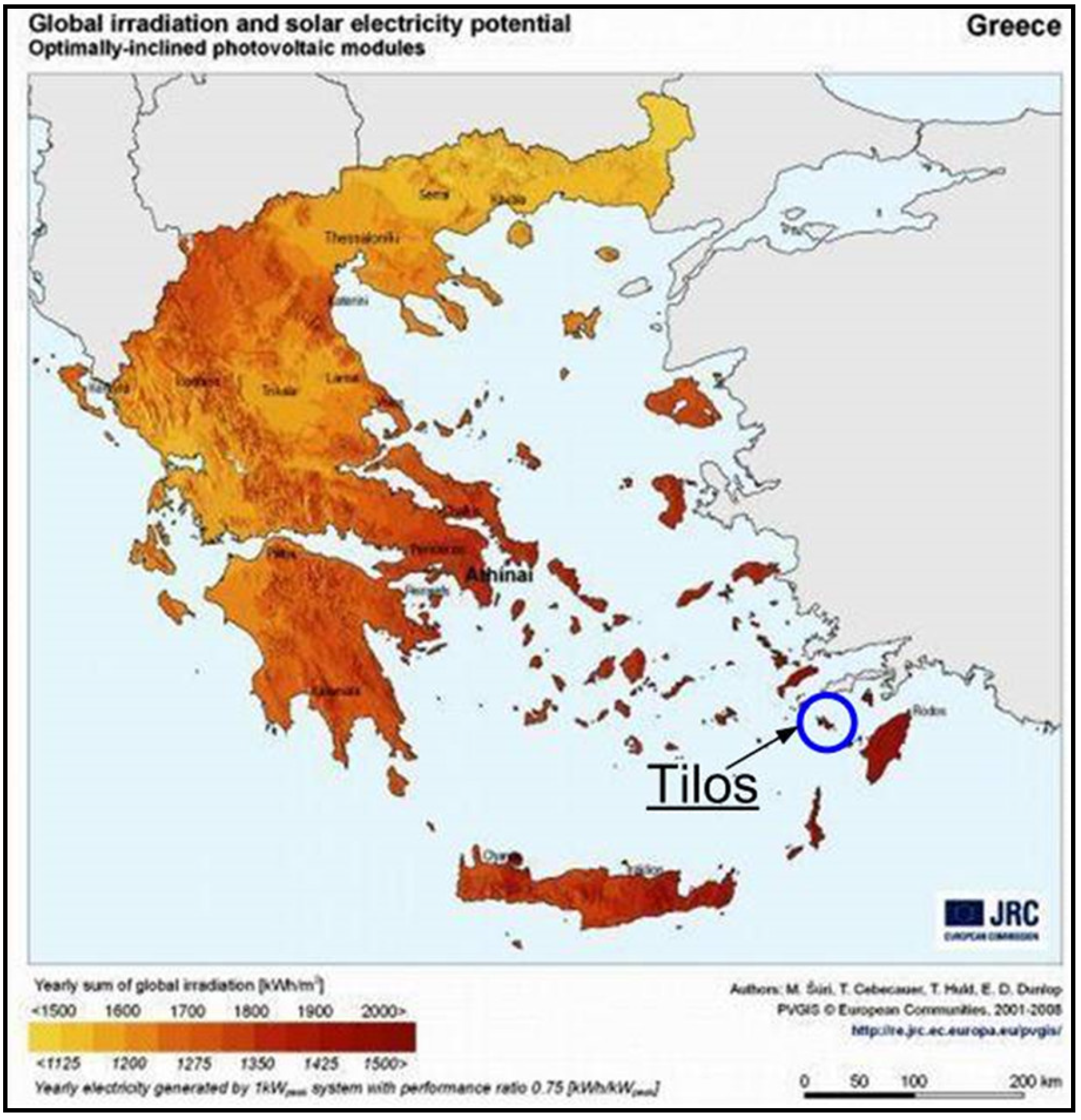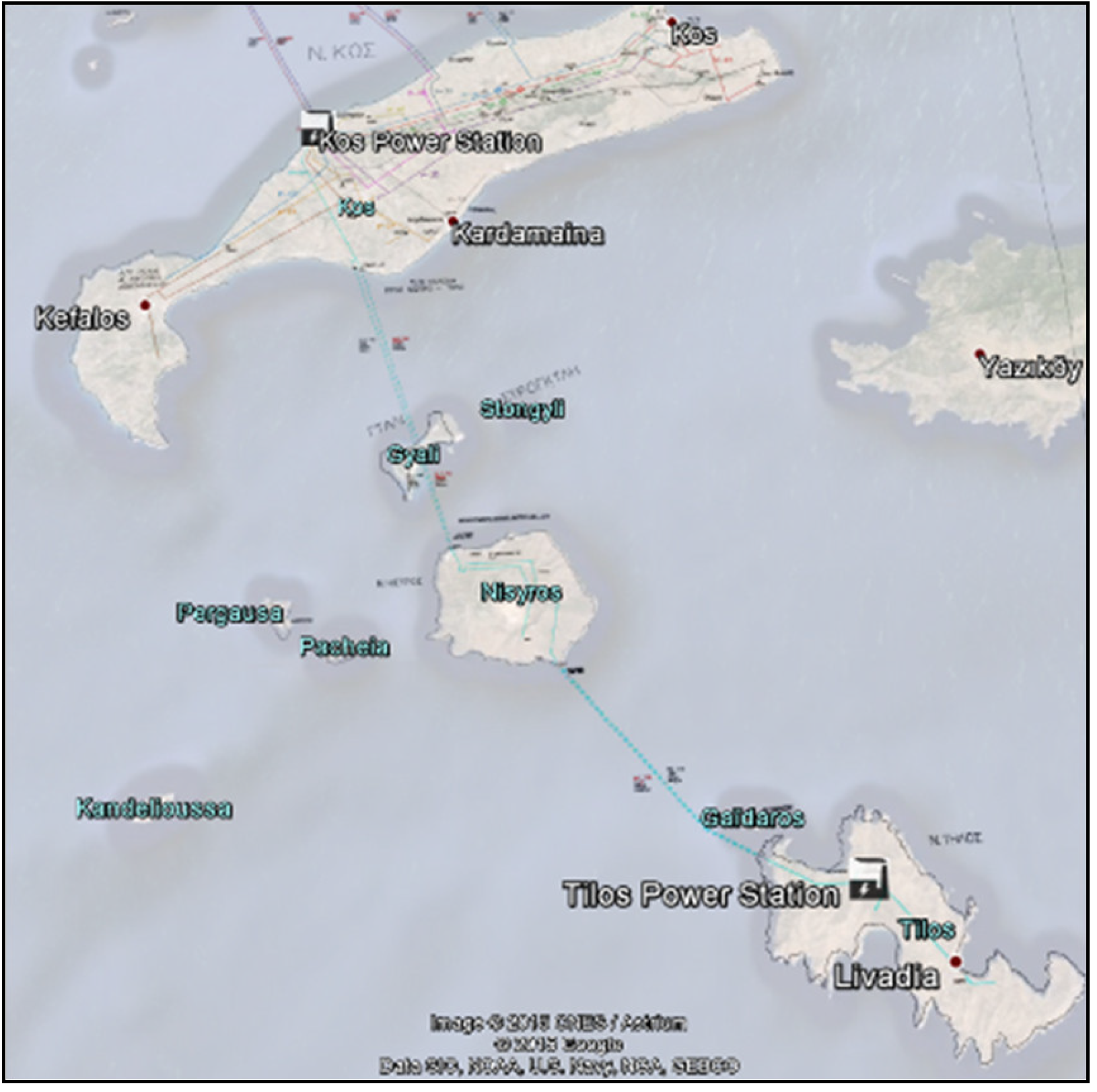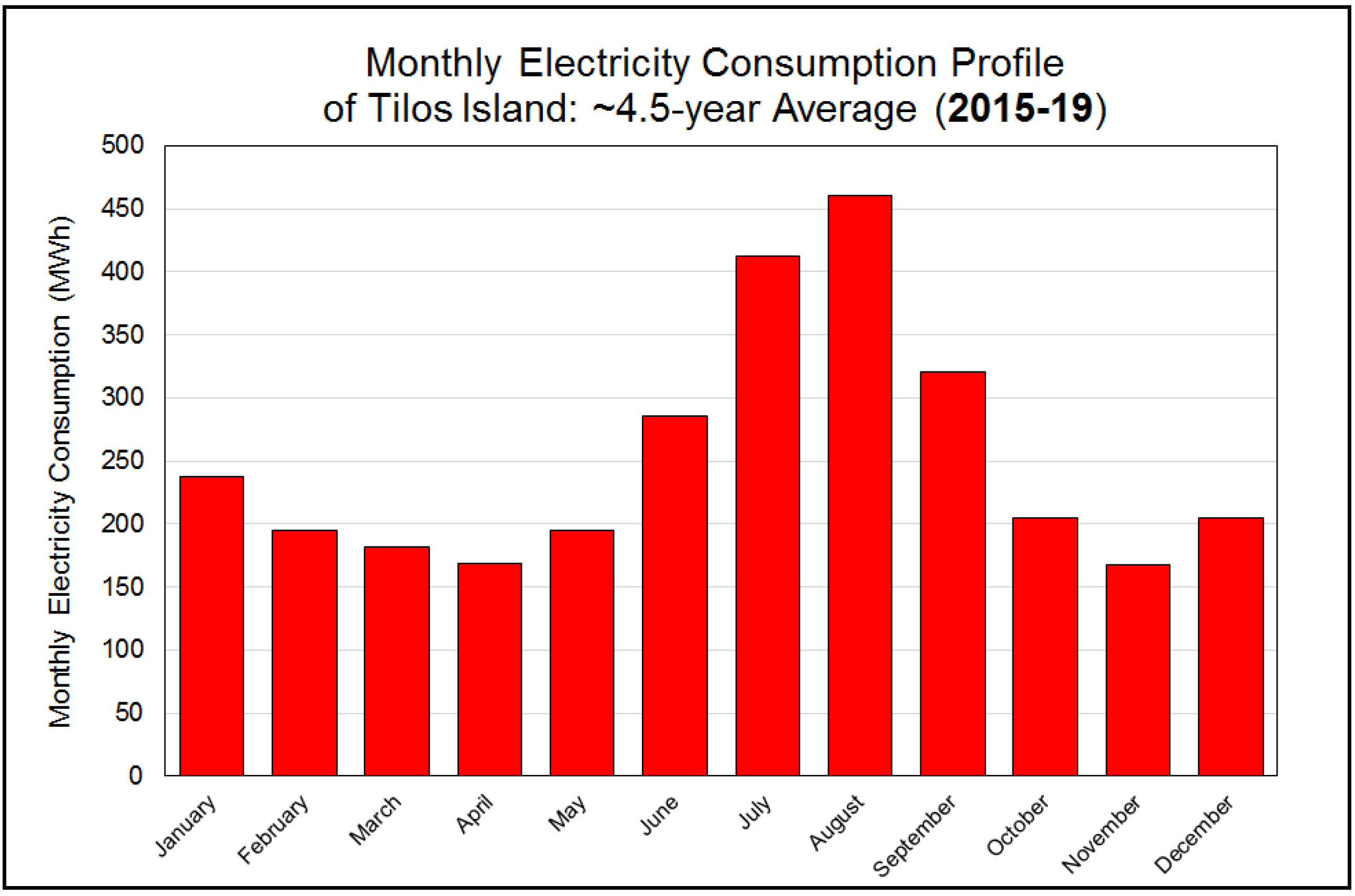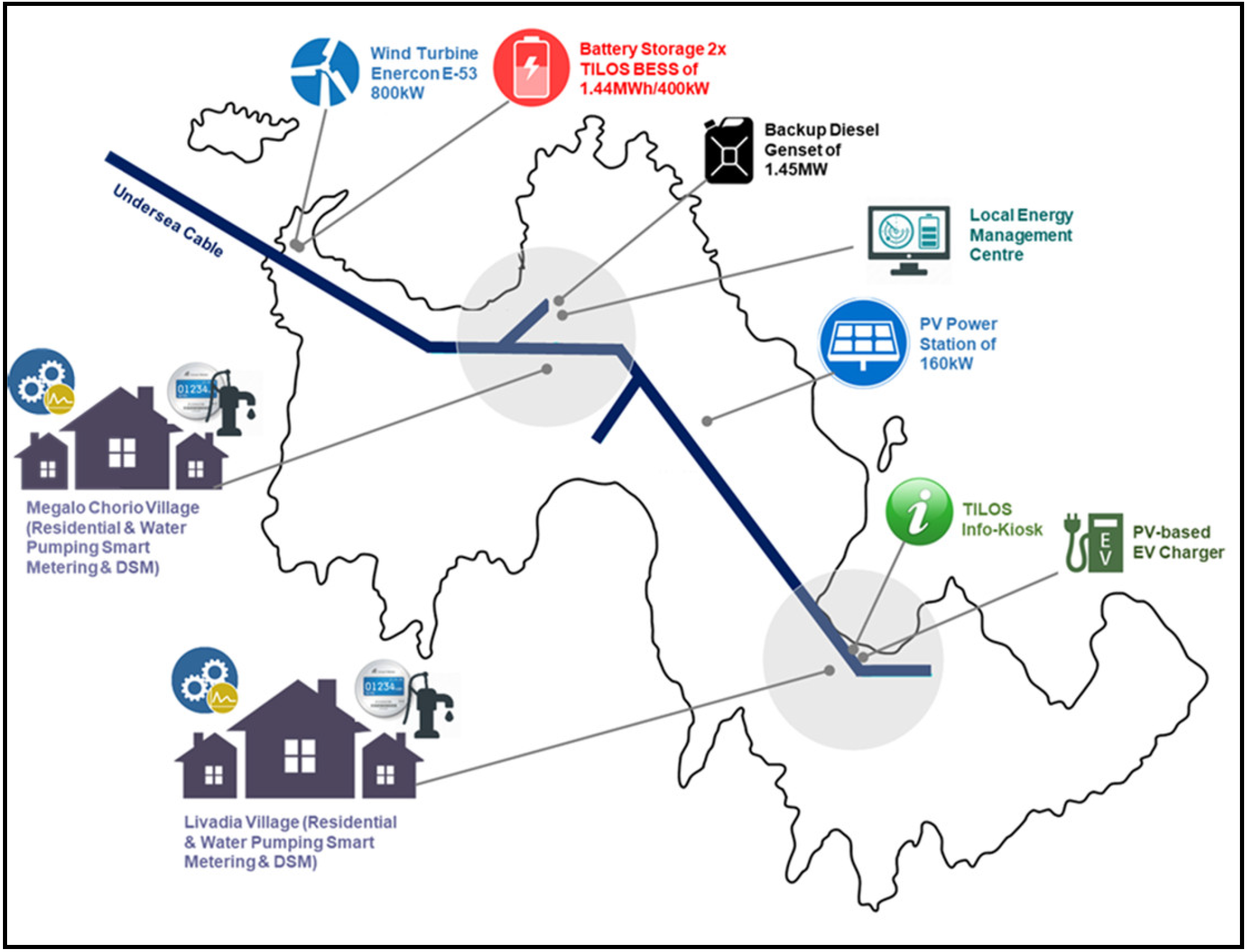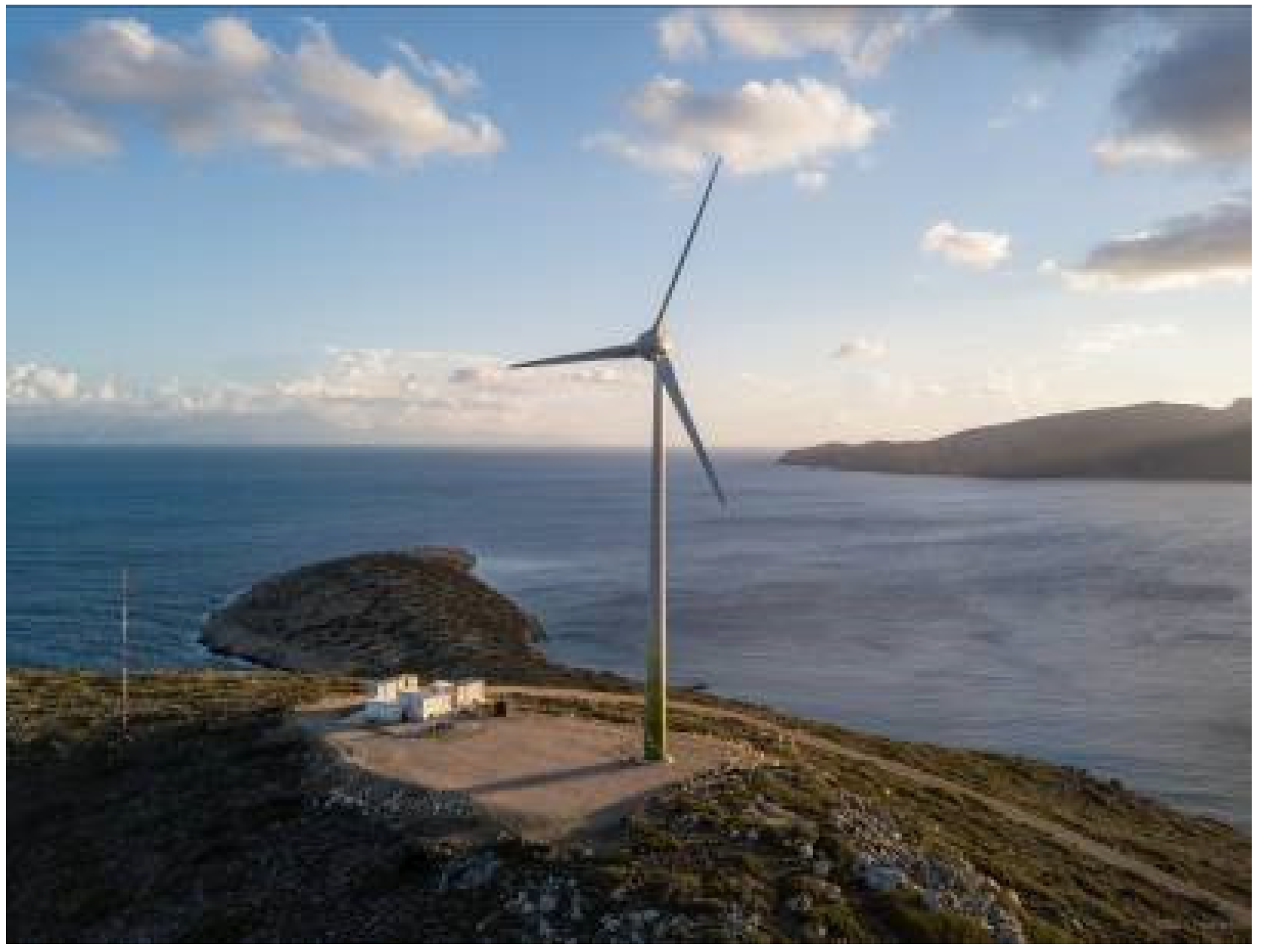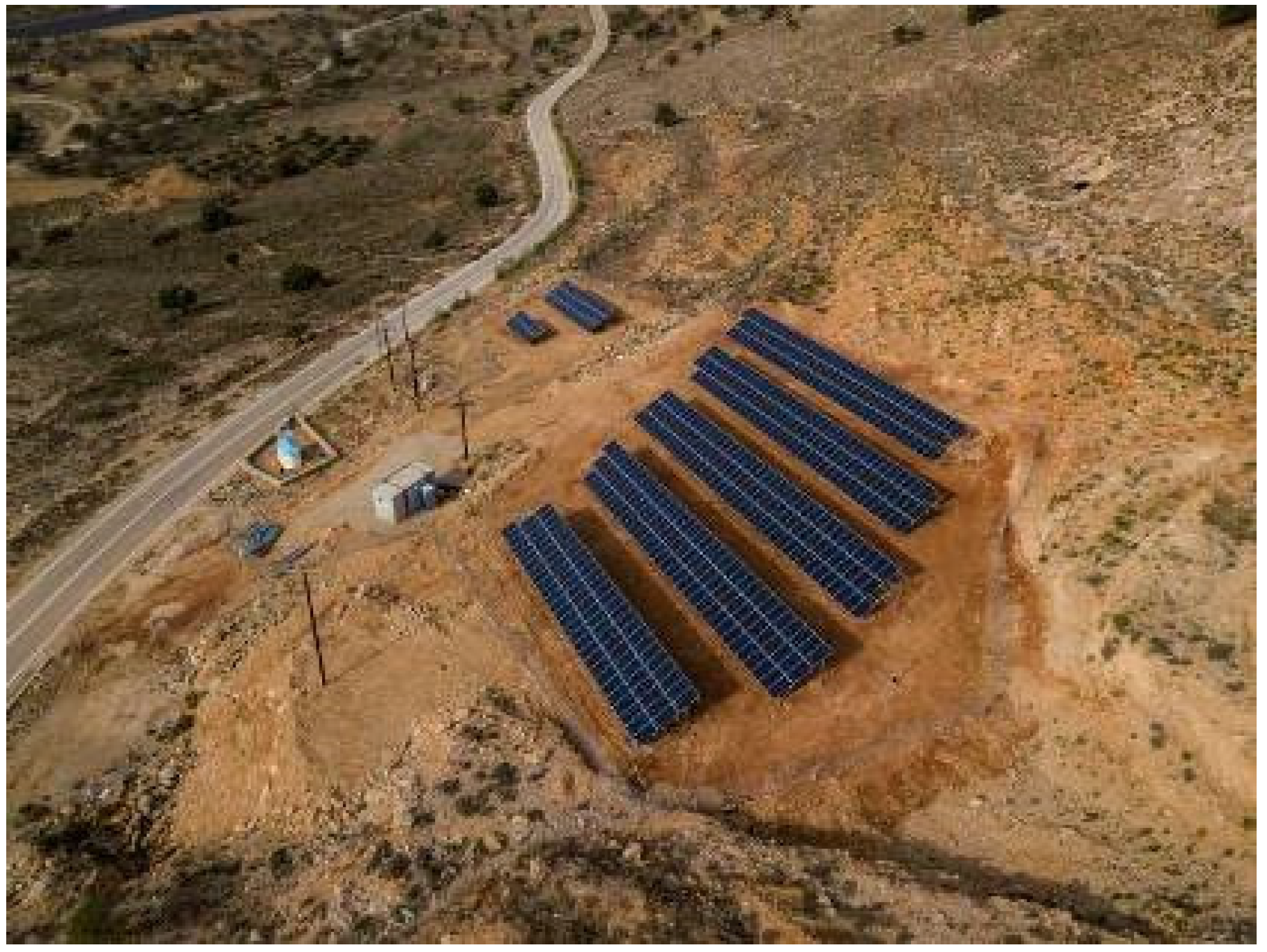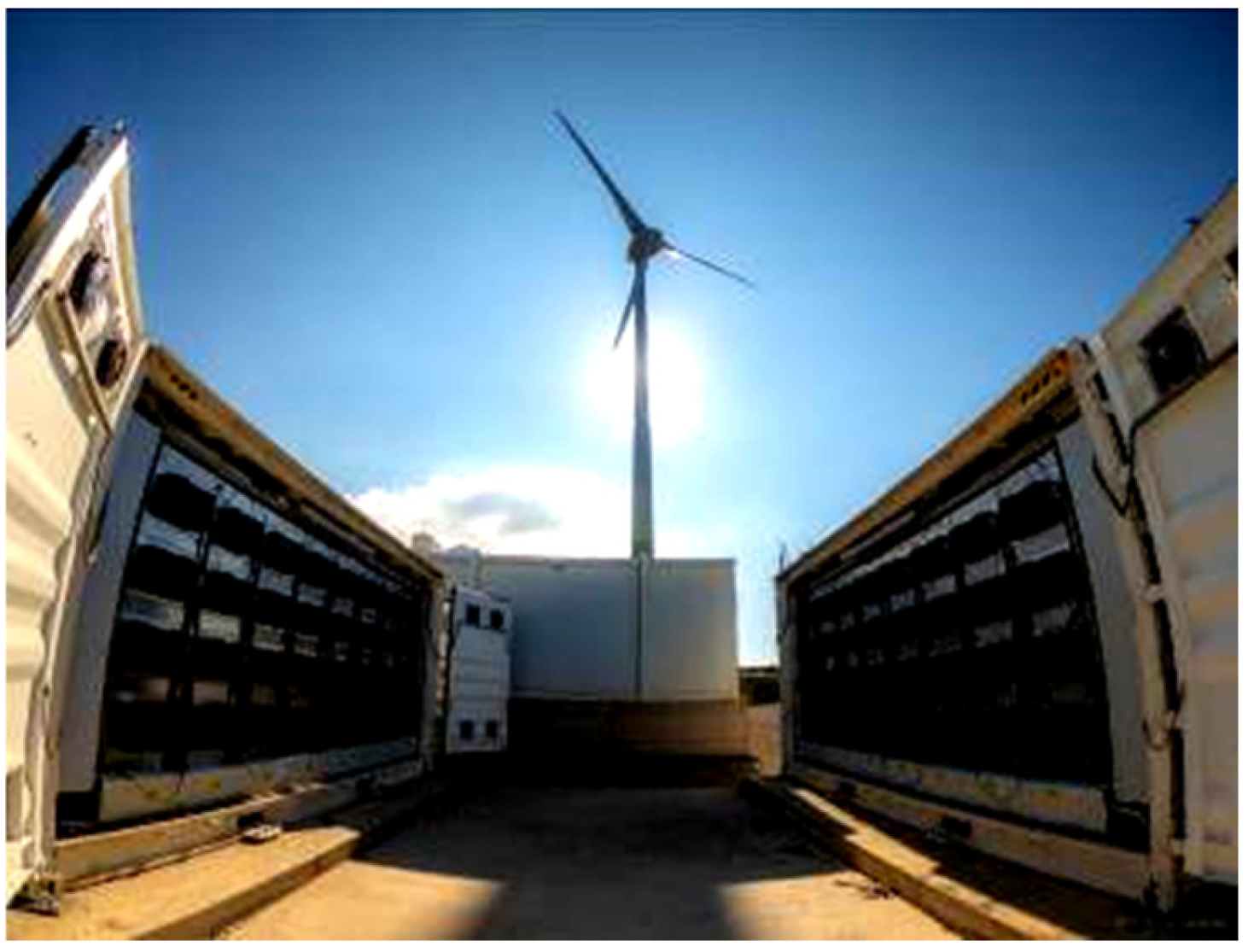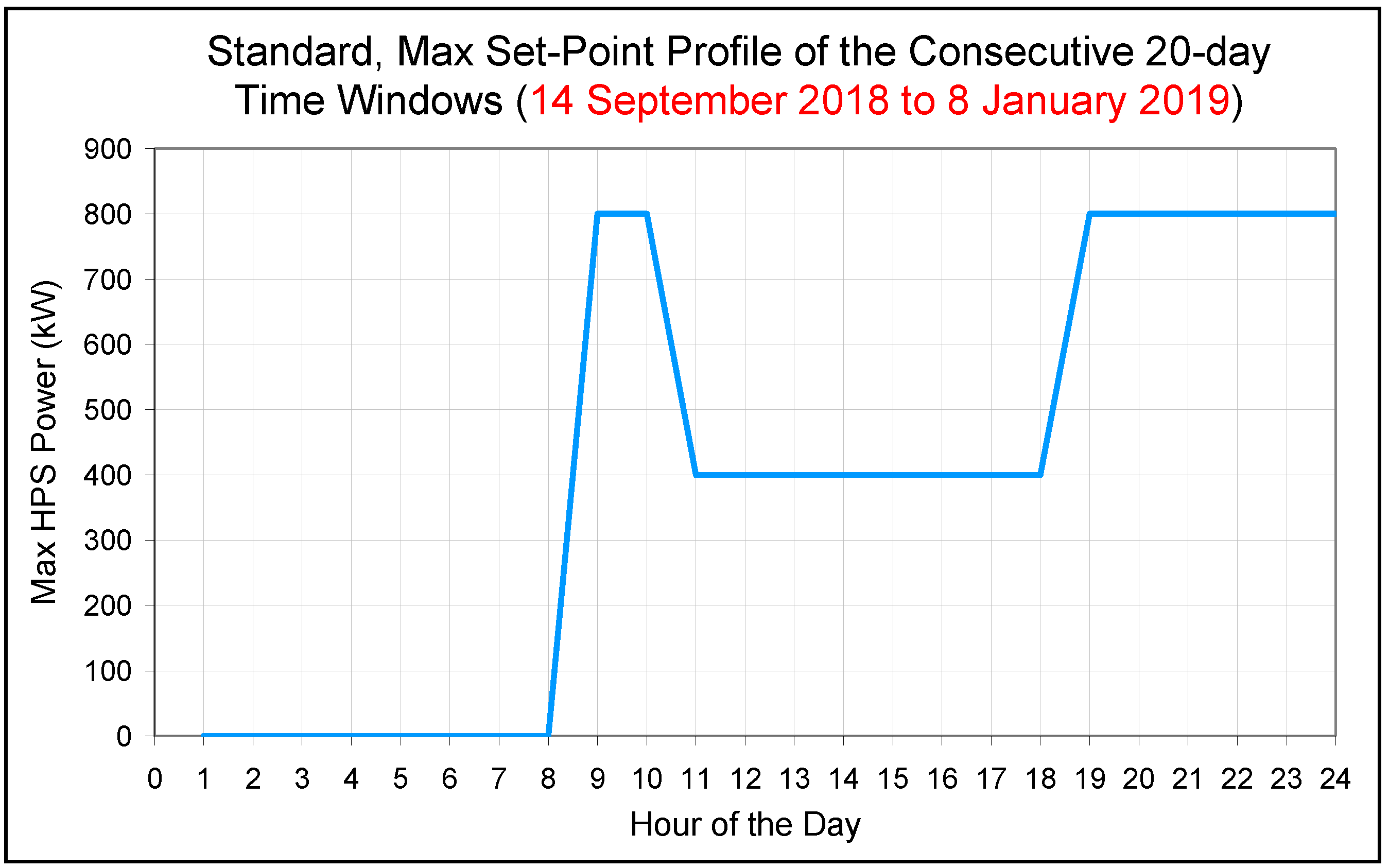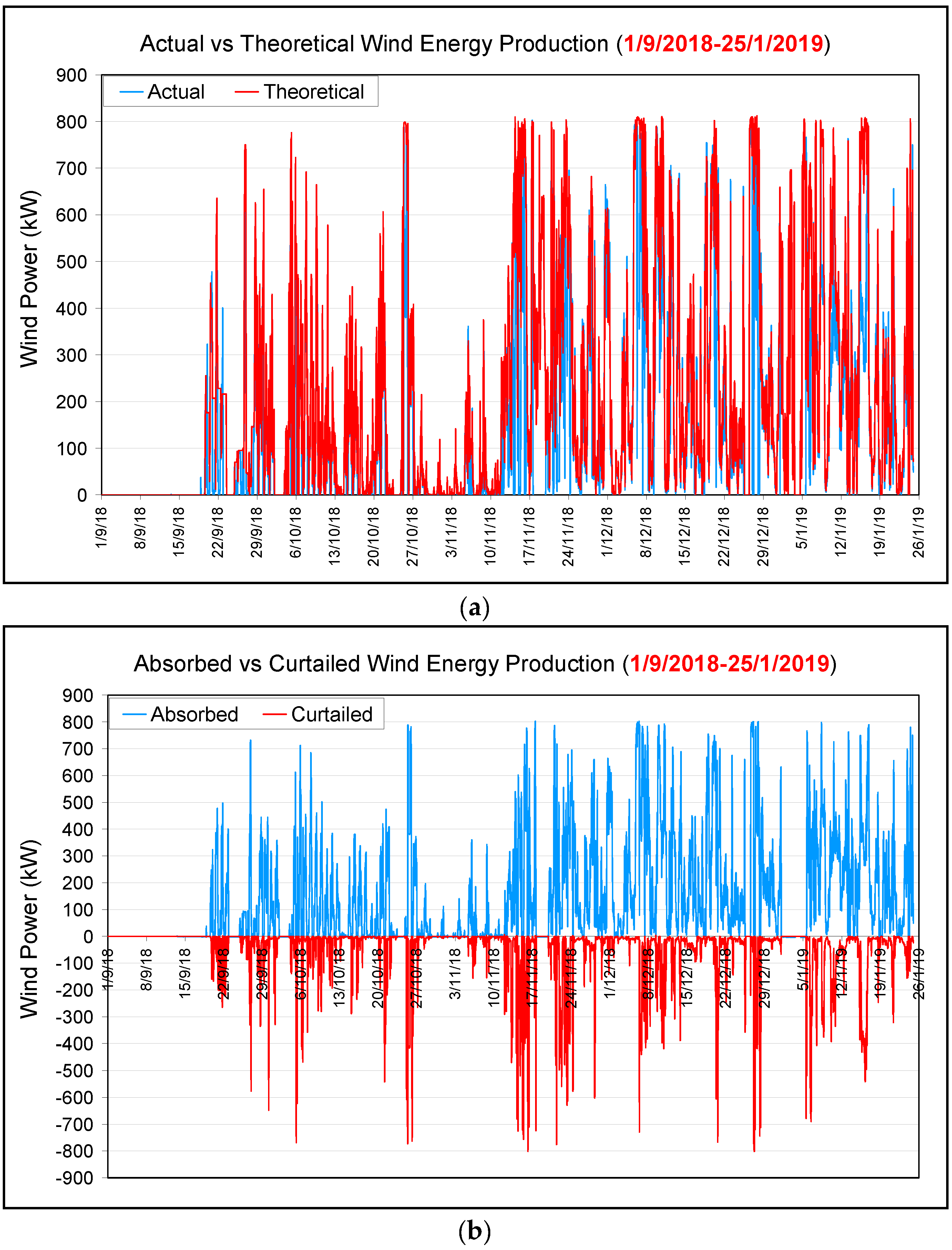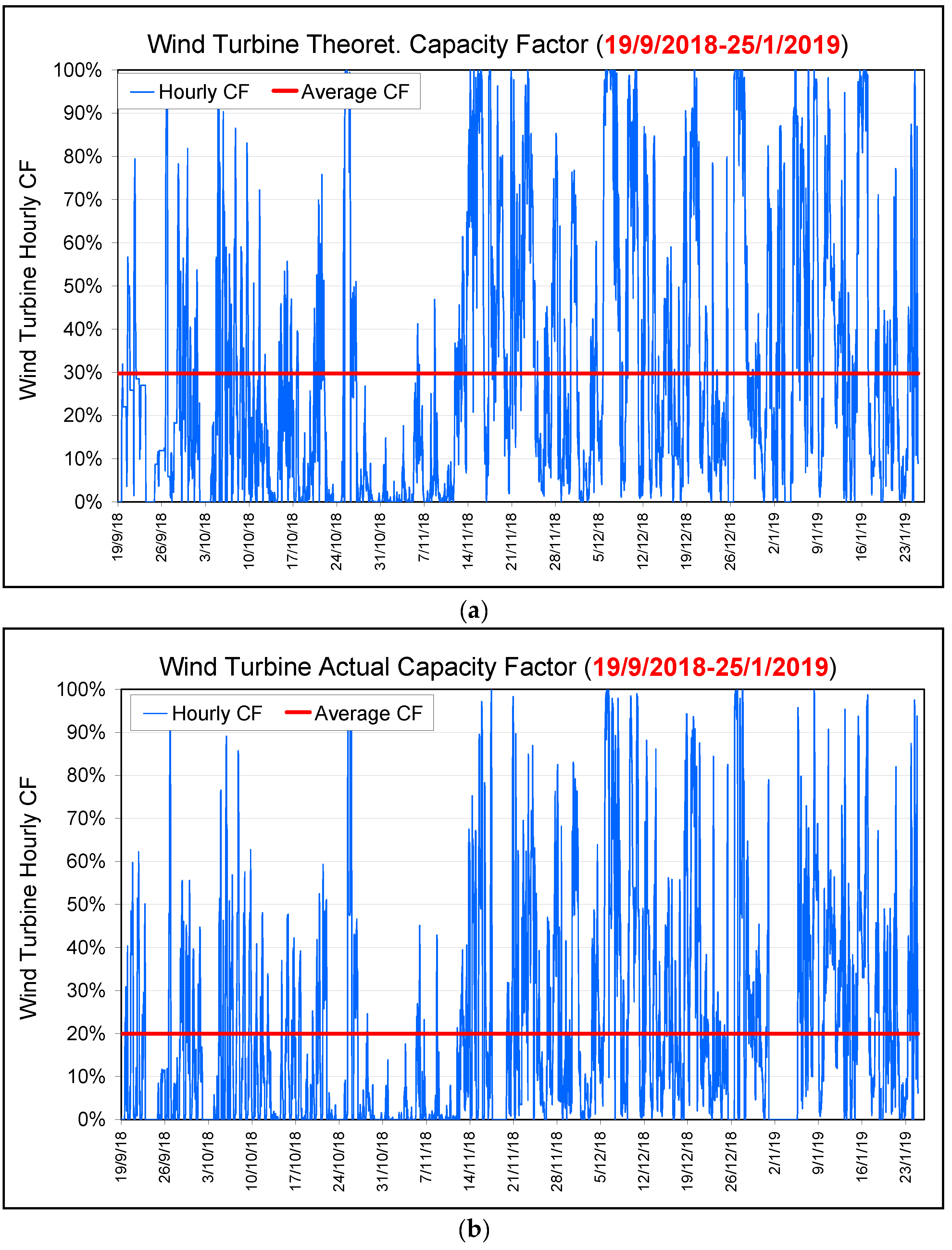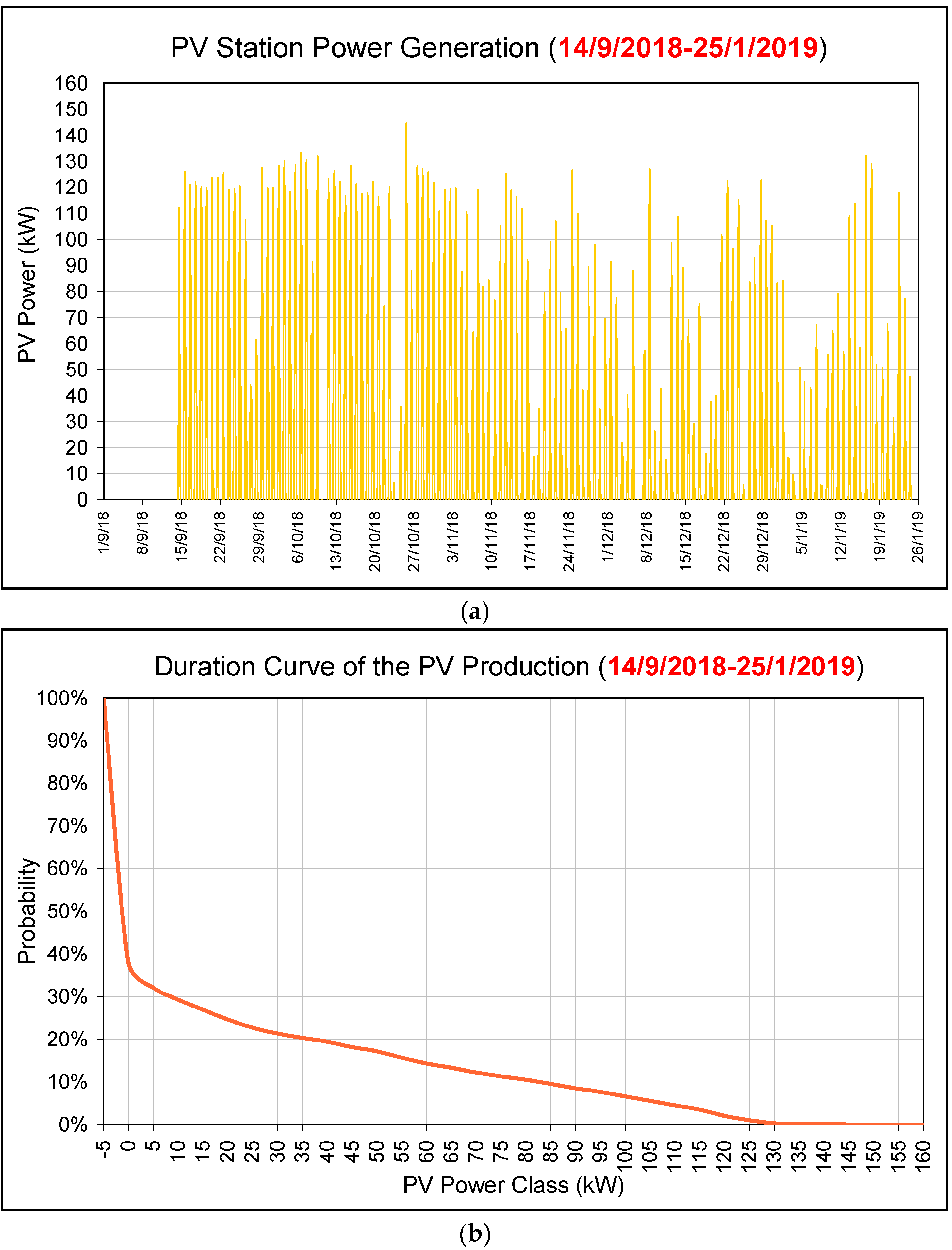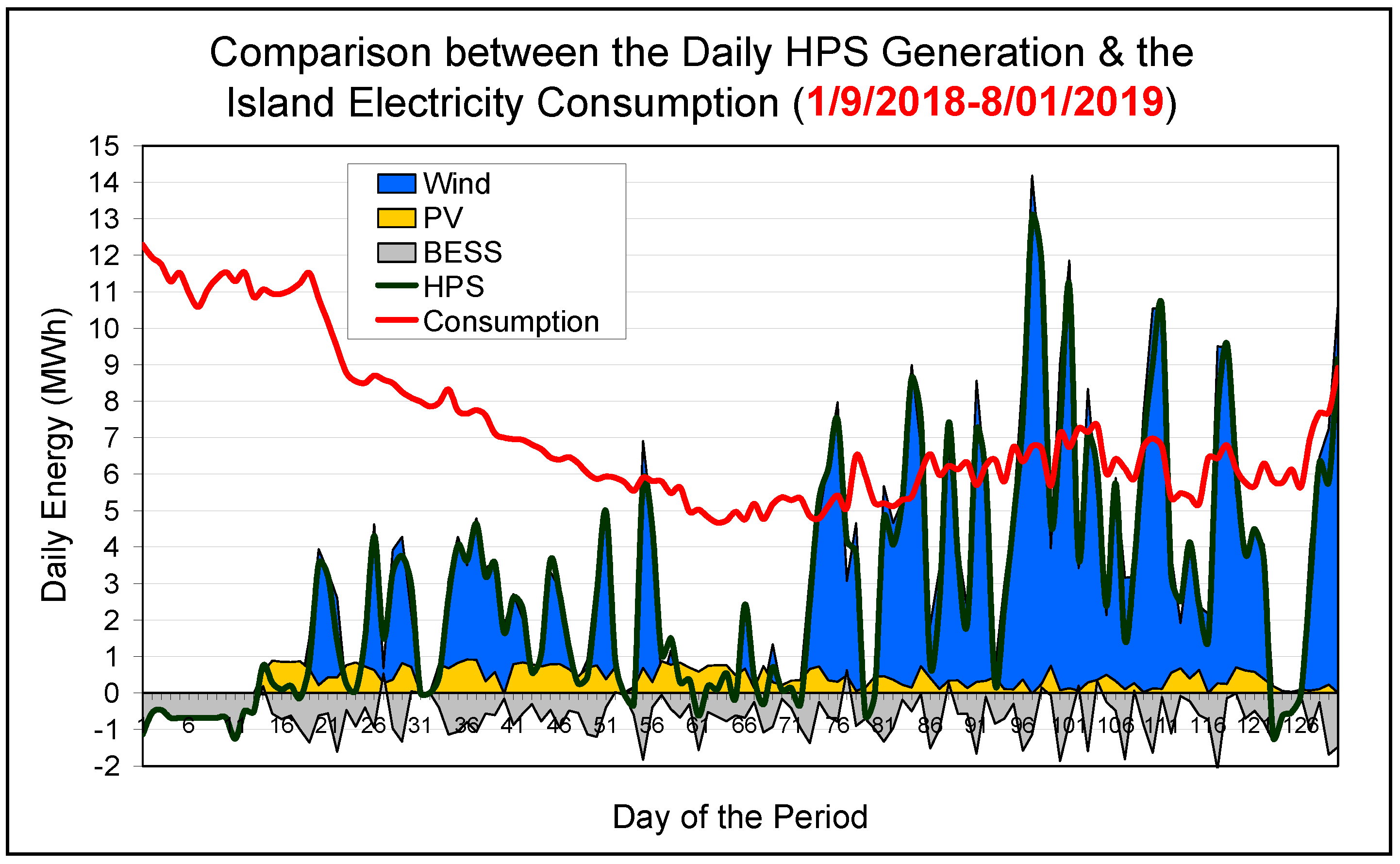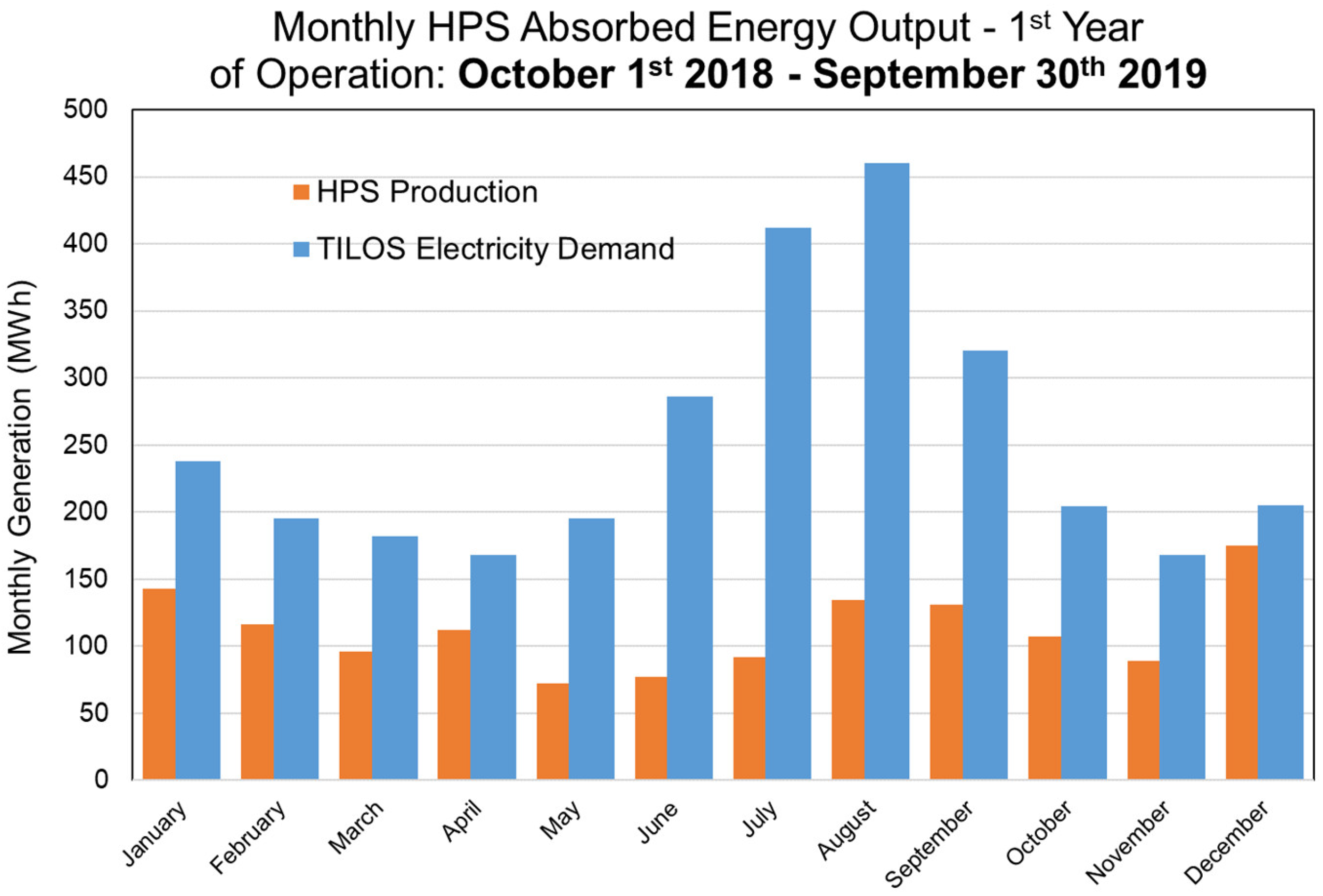2. Proposed Integrated Electricity Solution for Remote Islands
To improve energy autonomy and energy supply security of the several existing islands, an integrated solution has been developed (
Figure 4) based on the available wind and solar potential exploitation along with an appropriate energy storage infrastructure, introducing also some extra smart-grid elements. This solution is quite promising for various Greek islands belonging to the Aegean Archipelagos area, and particularly the most distant and small-scale ones.
More specifically, for every island, one should estimate the available RES (i.e., wind/solar/biomass and geothermal) potential. In this context, real-world operational data are necessary (see, for example,
Figure 5 and
Figure 6), originated—if possible—from long-term in situ measurements. Actually, for a period of three years (2015–2017), detailed measurements were carried out concerning the wind speed and the solar irradiance data as well as the main meteorological parameters by our research team (Soft Energy Applications and Environmental Protection Lab of UNIWA) [
14]. To this end, the expected RES-based annual electricity generation “E
tot” can be estimated by defining the maximum rated power “P
RES” for several configurations consisted of wind “P
w” and photovoltaic parks “P
PV”, i.e.,:
where “CF
w” and “CF
PV” are the capacity factor values of the selected wind turbines and PV panels according to the available wind and solar potential, correspondingly.
On the basis of existing licensing procedure in Greece, the maximum RES power to be installed on an autonomous island grid cannot exceed the local consumption peak load demand (e.g., 960 kW), hence:
Considering that the rated power of the smallest contemporary commercial wind turbine in the market is 900 kW, a similar machine has been selected and has been down-rated at 800 kW, in order to install also a small PV power station of 160 kWp. In the near future, additional PV panels may be added if the peak power of the island increases also, since the PV installations have the option of modularity.
Subsequently, using accurate measurements (
Figure 7), even on a sec-time-interval basis, stemming from official recordings, the pertinent load demand time-evolution is investigated to ensure the local electricity grid stability as well as the uninterruptible power supply of high priority loads. Furthermore, both deferrable loads as well as loads of secondary priority have been pinpointed (
Figure 8). Actually, in
Figure 8, one may find the electricity consumption needs for water pumping (including also water transferring between water tanks), which is maximum during the summer due to the increased tourist activities. In the same
Figure 8, one may find the monthly public lighting electricity consumption for the four villages of the island (Megalo Chorio, Livadia, Agios Antonios, Eristos). As can be revealed from the existing data, the relevant electricity consumption is also increased during the summer period since all the local tourist facilities are in operation. Finally, the technical specifications of the “in-operation” thermal power units and the actual interconnections deployed until now to satisfy the local load demand have been scrutinized as well.
Consequently, a thoroughly designed and sized energy storage system has been installed [
15,
16,
17,
18], to improve the electricity system power (active and reactive) balance and reduce the dependence on fossil fuels. The corresponding energy storage technology and its main operational parameters (i.e., input–output power, charging/discharging rate, round-trip efficiency, depth of discharge, energy capacity, etc.) are determined by the island’s peak load demand, its inherent characteristics (e.g., land availability, topography, etc.) as well as the degree of energy autonomy to be attained (or the intended maximum oil contribution in the island energy mix).
The introduction of DSM techniques in conjunction with smart meters for the major deferrable loads stands out as another crucial parameter for obtaining enhanced electrical grid power balance [
13,
19]. Moreover, load management may also be applied in the residential and hotel sectors as well as for other principal consumers of the island (
Figure 9). One of the most promising cases is the application of load management strategies at the existing eight (8) water pumping installations with maximum power of 70 kW, representing a considerable part (e.g., 15%) of the island’s average load. In this context, the local load demand can be adjusted to better match the available RES production without jeopardizing the local population living standards. Additionally, penetration of electric vehicles in the transportation sector of the island (
Figure 10) could also assist in this direction, with the local, relatively restricted (maximum distance 15 km), road networks suggesting the ideal ground for electro-mobility applications.
Furthermore, forecasting methods and associated systems can also be taken into account under the scope of upgrading the operation and ameliorating the flexibility of the complete electricity production system (EPS), while in parallel maximizing RES contribution. Such an example is the deployment of an innovative Forecasting Platform (FP) that is capable of providing reliable predictions of load demand, solar power and wind power generation several hours ahead [
20,
21]. The aforementioned features comprise the core of a High-Level Energy Management System (EMS) and Centre, in charge of coordinating the programming and optimum operation of the various subsystems of such an integrated solution. In this context, based on forecasting signals, the operation and dispatch strategy of energy storage can be improved, while also keeping end users informed on the potential for demand response, hence favoring RES contribution maximization and cost-effectiveness.
As a final point, it is important also to mention that all the aforementioned steps impose continuous education and interaction with the local community [
22]. To that end, close collaboration with the local authorities should be established, respecting their priorities, while at the same time the potential project developer should disseminate to the local people the information for the new infrastructure introduction and the benefits anticipated.
3. The Application Paradigm of Tilos Island
Tilos is a unique, small-scale “S”-shaped island found at the SE side of the Aegean Sea in Greece, a region of great symbolism and major geopolitical interest for Europe as a whole. Part of the Dodecanese group of islands, Tilos lies mid-sea between Kos and Rhodes (
Figure 11). Northwest to south-east, the island is ~14.5 km long, with a maximum stretch of 8 km and an overall area of approximately 64 km
2. Standing at a distance of 240 n. miles from the Greek mainland (Piraeus, Attica), Tilos belongs to the very special group of remote and small-scale European islands.
The island counts four main (populated) settlements/villages, namely, Megalo Chorio, which is the capital; Livadia, which is the biggest village and where the island’s port and main center of economic activities are found; Agios Antonios and Eristos.
The climate of Tilos is typical of the Mediterranean region, with mild winters and hot, sunny summers. Concerning the local RES potential, Tilos appreciates an excellent-quality solar potential, determined by ~1800 kWh/(m
2.a) at the horizontal plane (
Figure 6). On the other hand, the local wind potential is of medium quality, with the average wind speed ranging between 6 and 8 m/sec in the largest part of the island (see also
Figure 5).
According to the most recent census, Tilos has a total of 829 registered inhabitants. The actual population of the island during the winter months, however, is estimated to narrow down to ~400–500, as most of the residents move to the more populated, vicinal islands of Rhodes and Crete. The rest of the permanent residents gradually return to the island (between April and May each year), on time for the tourist season, with tourism suggesting the main economic activity on Tilos. In this context, and as already implied, the local population increases dramatically during the tourist season of the year, which normally lasts for a full 6 months (mid-April to mid-October). The island can host ~1200 visitors, with the number of tourists normally exceeding the hosting capacity of hotels and apartments by far, especially during the peak summer period of August.
3.1. Tilos Electricity Grid
Tilos belongs to the electrical complex of the Kos and Kalymnos islands, forming an electricity system of nine (9) islands in total, with Tilos located at the very southern tip of the complex. In more detail, Tilos is connected to the island of Kos via the R-44 feeder line (see relevant configuration in
Figure 12). The R-44 feeder (in light blue) departs from the central bus bar at the Kos thermal power station, has three underwater sections between four islands and serves—via overhead lines—a few MV consumers on the Kos and Gyali island, as well as the entire electricity demand of the Nisyros and Tilos islands. Moreover, and for redundancy reasons, there are two undersea cables, each corresponding to a different cable link on Kos, with only one being typically operated, which means that the switch from one side of the second link remains open.
The feed-in point from Kos stands also as a point of common coupling between the broader electricity system of Kos and Kalymnos and the electrical grid of Tilos. This means that Tilos can be isolated from the R-44 line and thus be operated as a completely independent, geographical island microgrid, relying exclusively on its own power generation sources.
The Kos and Kalymnos island complex, to which Tilos belongs, comprises, as already mentioned, an electrical system of nine (9) islands, with an installed capacity of ~145 MW (mainly thermal, oil-fired units), an annual peak load demand of more than 90 MW and an annual electricity demand in the order of 365 GWh
e. The system relies mainly on the thermal power station of Kos island (capacity of ~102 MW), employing heavy-oil fired engines of 87.3 MW and diesel-fired units of 14.6 MW, and secondarily on the thermal power station of Kalymnos (capacity of 18.15 MW), employing heavy-oil units alone. At the same time, RES units across the complex (excluding Tilos) include four wind parks of total installed capacity equal to 15.2 MW and 92 PV parks of ~8.8 MW
p in total. The annual energy yield of the latter is estimated in the order of 16.6 GWh (capacity factor of ~19%), while for the existing wind parks, the estimated annual energy yield reaches almost 46 GWh (capacity factor of 34.5%) (see also
Figure 6), with 1/3 of this number, however, being curtailed. This reflects the saturation levels of the Kos and Kalymnos electricity system in terms of RES capacity. More specifically, due to the dynamic penetration limit for RES on the one hand (e.g., RES contribution should be no more than 30% of instantaneous load demand) and the technical minima of the in-operation thermal units on the other, the residual load available for the absorption of considerable RES power generation is significantly reduced. The specific shortcoming is critical for the further increase of renewables in the system, which, if not supported by energy storage and/or new interconnections, does not seem to suggest an economically viable option.
The average load demand profile of Tilos currently adopted (
Figure 7) is configured on the basis of a long-term measurement campaign carried out within the context of TILOS project, covering a period of almost 4.5 full years, i.e., from mid-2015 to autumn 2019 on the basis of 10 min measurements. To this end, the total electricity consumption of the island is found (
Figure 13) to marginally exceed 3 GWh
e (3.035 GWh
e), while the average peak demand of the year exceeds 800 kW, although, if looking at individual years, summer peak demand is actually in the order of 900 kW.
3.2. Tilos Hybrid Power Station
In view of the successful implementation of the TILOS project, the first-ever battery-based, wind and PV Hybrid Power Station (HPS) in Greece has been developed. At the same time, an integrated microgrid has also been developed on the island and several innovative elements have been introduced, altogether transforming Tilos into an exemplary island case in terms of local-scale clean energy production and management.
This comprised a major breakthrough, not only for Tilos, but also for the Greek energy market as a whole, disrupting the norms of the past and presenting a new energy paradigm and solution for the electrification of island regions. Acknowledging the above, the main assets and elements of the power generation side are first presented.
Concerning the electricity generation sector, the main power generation assets that are currently in operation on Tilos include:
the Tilos HPS, comprising:
- ○
an 800 kW, medium scale wind turbine
- ○
an 160 kWp PV station
- ○
an 800 kW/2.88 MWh integrated Battery Energy Storage System (BESS)
the back-up diesel genset of 1.45 MW, located in the village of M. Chorio
distributed, small-scale PV installations supporting early prosumer schemes and including:
- ○
two monitored PV installations in M. Chorio & Livadia (capacity of 3.36 kWp at local residence and 4.93 kWp at the TILOS info-kiosk/EV charging station respectively)
- ○
four non-monitored PV installations (operational capacity of ~10 kWp in total).
The above assets, together with the rest of the innovative elements that will also be analysed in the following paragraphs, comprise the integrated Tilos energy solution. As also reflected in
Figure 14, the integrated Tilos energy solution suggests an energy microgrid that is normally found to interact with the host electricity system of Kos and Kalymnos (mainly the HPS), or, in rare cases, operated in isolation (such as in cases of emergency or microgrid testing).
3.2.1. HPS-Wind Turbine
The Tilos HPS wind turbine was installed in June 2017 by the Greek energy company, Eunice, which acted both as a private investor and a major partner of the TILOS project. As can also be seen from
Figure 14, the wind turbine is co-located with the HPS battery storage system, at the northwestern tip of Tilos (area of Pachy), next to the undersea cable junction (
Figure 15). To this end, the main technical features of the Enercon E-53 wind turbine are provided in
Table 1.
3.2.2. HPS-PV Plant
The Tilos HPS PV plant was also installed in June 2017 by Eunice, and is located at the central part of the island (
Figure 14 and
Figure 16), sharing the distance between the villages of M. Chorio and Livadia. The PV plant is comprised of 592 polycrystalline PV panels of 270 W
p maximum capacity each, manufactured by JA Solar. Every 74 panels form an array with a maximum capacity of 19.98 kW
p and are connected to the respective array inverter of 20 kW nominal capacity, manufactured by FRONIUS. The produced energy is collected from each string inverter and directed to the MV transformer and consequently to the local grid overhead lines. To this end, the main technical features of the PV panels employed are provided in
Table 2 on the upper right, together with additional information, such as the exact location of the installation.
3.2.3. HPS-BESS
The integrated battery system of Tilos was fully installed on the island in January 2018, following the earlier installation of two battery containers and the introduction of individual battery modules right after. It comprises a fully containerized solution based on the high-temperature NaNiCl
2 technology, standing as a fully recyclable storage configuration. The battery modules, which are manufactured by the Italian FZSonick, i.e., one of the lead partners of TILOS, under the type FZSonick ST523, are containerized into two 20 ft containers (
Figure 17). Each of the containers comprises an energy storage system of 64 FZSonick ST523 modules that are connected in parallel. The technical specifications of the battery module and of the standard energy storage application are provided in
Table 3. Concerning the AC side, each of the battery containers is connected to a dedicated battery inverter (PCS) manufactured by the Swiss Indrivetec (IDT). The two employed inverters are of 500 kVA each under the type SOLO S and are combined with two 630 kVA, 20/0.3 kV MV transformers, altogether forming the battery AC side. The inverters’ main specifications are given in
Table 4.
In contract with the two RES units, the integrated BESS was commissioned in April–May 2018. This enabled the energization and warm-up of the battery modules and allowed for the execution of a series of Site Acceptance Tests (SAT). The SAT lasted for a total of 2 weeks and included communication tests, software integration, emergency tests, battery warm-up, power exchange between containers, cycling, grid perturbation and internal black start, as well as a set of set-point profile tests.
3.3. Tilos Island Demand Side Management
Following the detailed presentation of the generation side and energy management aspects, the demand side of the island is next presented, with the focus given on the Smart Metering and DSM platform of Tilos, bringing together a pool of almost 100 end consumers and community loads. Note that the remote electricity grid of Tilos comprises a vulnerable system often faced with power cuts, which affects living conditions on the island in an adverse manner, hindering also economic activities, especially during the summer period.
Concerning consumers, there are no MV customers on the island, neither large-scale consumers, which is attributed to the lack of local industrial activities. Essentially, it is the local residential and tertiary sector that carry the biggest share of electricity consumption, with local hotels and summer apartments increasing the local demand during the summer period, altogether belonging to the broader category of the building sector analysed accordingly.
Apart from the local building sector, other important sources of electricity consumption correspond to community-scale loads, such as water pumping (a total of 8 water pumping systems of ~62 kW and several smaller scale borehole pumps for irrigation) and public lighting (see also the respective monthly consumption profile in
Figure 8), while grid-connected is also the telecommunication infrastructure of the island.
As already seen, the Smart Metering and DSM platform, developed by Eurosol (also partner of TILOS) and currently owned by local end users and the Municipality of Tilos, comprises one of the main components of the integrated energy solution of Tilos, bringing together a pool of ~100 Smart Meter and DSM panels (
Figure 9). The prototype DSM panels can be used both directly by local end users (mainly for electricity consumption monitoring) and offer a pool of controllable loads. In this context, the DSM platform can in aggregate serve different purposes in order to improve the operation of the Tilos microgrid (e.g., load shifting in favour of increased RES shares or control of loads during recovery from black-out events / stand-alone island operation of Tilos in support of the local HPS operation, etc.), comprising at the same time the end-nodes of the integrated Smart Metering and DSM platform. The latter is also responsible for the monitoring, data collection, classification and remote, centralized control of all active DSM loads, acting at the same time as an integrated element of the developed High-Level Energy Management Centre (HL-EMC). DSM panels were gradually installed during the implementation of TILOS, distributed across local residences, hotels, commercial stores and the public sector, as well as in eight (8) water pumping stations of the island standing as community-level loads. Their distribution over the two main villages of Livadia and M. Chorio is given in
Figure 9, followed by the distribution of controlled community loads across the entire island.
Apart from the monitoring and control of loads at the end-user level, the entire pool of loads can also be centrally monitored at the DSM server, co-located with the HL-EMS server at the old power station of the island. Following the commissioning of the HL-EMC/EMS, the Smart Metering and DSM solution acquired a twofold role, acting as an independent system branch (aggregate pool of DSM loads that can support different types of grid services) on the one hand, and supporting interoperability with the rest of the system components as part of the HL-EMC on the other. In this context, load demand monitoring is also active in aggregate fashion, supported by an advanced UI and relevant dashboards that group together DSM loads per type of end user.
In the meantime, further classification, based on the type and elasticity/flexibility of loads has been carried out. What should be stressed at this point is that the total DSM loads’ installed capacity rises to more than 700 kW, which is expected to ensure a minimum DSM pool of 15–20% in comparison to the appearing load demand of the island at all times.
4. Evaluation of Tilos Island Solution
After the completion of the commissioning phase for the RES units, the HPS of Tilos became fully functional and, as such, it entered the “prosumer” stage of operation. To this end, consecutive, 20 day duration time windows of trial operation were exploited in order to test the HPS performance, first under a certain daily profile/schedule of max-permitted power output per hour of the day. The specific profile (provided by the local network manager-Kos APS) is depicted in
Figure 18 (with the max-permitted power output of the entire HPS set to vary between the fixed values of 0 kW, 400 kW and 800 kW) and it is the one governing the operation of the HPS from mid-September until early in January, i.e., when a second round of trial operation started for the testing of different set-point profiles for the HPS.
More specifically, following the issuance of all the necessary permits in 2018, the wind turbine was commissioned in mid-September and was fully activated on September 19, 2018, i.e., when it started generating power as part of the integrated HPS of Tilos. With regards to its anticipated energy performance, the medium quality wind potential of the area (long-term average wind speed of ~6.5 m/sec at 30 m height, based on on-site measurements from a dedicated wind mast) produces an annual capacity factor of 27.5–30% concerning the theoretical output of the machine, which is equivalent to an annual power generation between 1.9 GWh
e and 2.1 GWh
e. However, during the examined period, the actual wind energy production falls below these numbers, owing primarily to the saturation levels of the overall Kos and Kalymnos system noted earlier, with the ex-post capacity factor estimated in the area of 20%. In addition, and during the demonstration stage of the TILOS project, that coincided also with the very early period of HPS operation, trial tests for the HPS dictated the application of certain set-point profiles, which further compromised the exploitation of local wind energy production. The combined impact of the two is better reflected in the figures (
Figure 19a,b), comparing the actual and theoretical production of the wind turbine till the end of January 2019 (end-month of TILOS project).
To this end, the levels of wind energy curtailments encountered are better illustrated in
Figure 19b, while another way to express and quantify the difference between the potential and the actual wind power generation is given in the results of
Figure 20a,b, where the actual and theoretical capacity factors are compared. In this context, the resulting average difference is in the order of 10%, i.e., the expected capacity factor on the basis of the available wind potential and operational curve of the wind turbine used is almost 30%, while the finally absorbed wind power by the local grid corresponds to capacity factor value equal to 20%. This real-world situation means that 1/3 of the energy yield of the wind turbine during the given period was curtailed by the local network operator due to limited electricity demand and the restrictions imposed by the local grid stability and the existing thermal units technical minima.
Similar to the case of the wind turbine installation, commissioning of the PV station was also successfully completed in September 2018, enabling power generation on the 14th of September 2018. To this end, and as far as the expected energy performance of the PV station is concerned, the excellent solar potential of the area (~1800 kWh/(m
2.a) at the horizontal plane) produces an annual capacity factor of ~18–19% concerning the theoretical output of the station, which is equivalent to an annual power generation between 250 and 270 MWh
e. Although subject to considerable curtailments as well, the PV station is considered to be less vulnerable in comparison to the wind turbine, mainly owing to its more dispatchable character as a renewable energy source. In this context, energy generation results from the operation of the PV station during the period examined are shown in the following
Figure 21. As one may see in this figure, the maximum power output is limited in the order of 130 kW, owing to the winter season encountered during the reference period. On the other hand, it is for almost 80% of the time (including night-time periods) that the PV generation output falls below 40 kW, which compares unfavorably with the local load demand and also challenges the predictability of the RES resource, especially with regards to the obligation of the HPS to provide day-ahead guaranteed energy offers. Concerning the capacity factor of the PV station over the demonstration period of TILOS, it was estimated at 12%, which for the specific (September to January) season of the year is considered satisfactory.
Recapitulating, in
Figure 22, we demonstrate the daily energy balance between the HPS production and the local island electricity consumption, together with a breakdown of the HPS production to its main components (i.e., wind turbine, PV station and battery operation). Note that during the first two weeks of September the HPS had not received the energy production licence, thus electrical energy was consumed (imported by the local grid) in order to keep in operation (at desired temperature) and test the two battery banks. As one may see, for the first two months of operation, the HPS contribution was moderate, directly dependent on both the performance of the wind turbine and the hourly cap on the basis of the adopted schedule (
Figure 18). Following the end of that initial period, which coincides also with a considerable reduction of the load demand and an improvement of the wind turbine performance, contribution of the HPS to the local consumption was found to increase remarkably, especially during December 2018, even under these sub-optimal conditions of operation imposed by the local network management.
What is worth noticing is that for December, local-only RES shares exceeded 70%, which, impressively enough, even reach 90% of the local consumption if RES imports and exports are also taken into account. On the other hand, RES shares during the summer period drop in the order of 25–30%, which is due to both the lower wind energy yield and the higher electricity demand appearing during that period (see also
Figure 23). Note that even these extremely low RES participation values are quite higher than the ones appearing in
Figure 1, not exceeding 22% in any occasion. As one may see from
Figure 22, the inclusion of RES exports makes little difference, which reflects on the increased curtailments faced over the period of study. On an annual basis, the energy provided of the Tilos island HPS is slightly less than 1500 MWh
e, mainly due to the local network curtailments and the poor exploitation profile dictated by the local network manager, completely neglecting the values provided by the existing forecasting algorithms.
5. Conclusions and Proposals
The implementation of the integrated TILOS energy solution under the current local legislative frame is a great success story introducing several important innovative characteristics in the European market. More specifically, the combined operation of a wind turbine and a PV installation (hybrid power station), the application of new technology battery energy storage, the installation of DSM network/platform and the development of a large number of reliable forecasting algorithms are among the main results of the proposed strategy.
Undoubtedly, the core component of the integrated TILOS solution, i.e., the local HPS, carries a bundle of innovative features synopsized below:
The HPS of Tilos comprises the first-ever, fully licensed, MW-scale, battery-based HPS in Greece. As such, it disrupted the local energy market and introduced new aspects in the Greek energy agenda, especially with regards to non-interconnected island electricity systems.
Although rather sophisticated, the Greek regulation for HPSs was tailored to the operation of pumped hydro, concerning the storage technologies employed. A series of advancements were introduced to this end to the local regulations within the context of TILOS in order to accommodate the operation of battery-based HPSs, positively affecting the early-stage storage market of Greece as well.
The HPS of Tilos has been the first to comply with the requirements of a day-ahead dispatch operation that is based on the declaration of guaranteed energy (power) offers and which entails the need for the exploitation of forecasting means as well.
The integrated BESS is able to offer a bundle of services including RES balancing and ancillary services to the local grid, like frequency and voltage regulation, while, under a set of conditions, it can also support black-starting of Tilos; thus standing as a novel, multiple-service storage system.
To our knowledge, the microgrid of Tilos is one of the most advanced island microgrids in Europe with smart aspects and many novel technologies and components. All these novel elements, following the TILOS project demonstration stage, are gradually evolving in order to support the operation of a mature energy ecosystem, fostering in the course of time the addition of new agents and actors such as the envisaged pool of prosumers, towards the full-scale decarbonisation of the island of Tilos.
As far as the energy performance is concerned, evidence of operations that are drawn from the core period of TILOS project demonstration stage (i.e., May 2018 to January 2019) is provided. The specific period is exploited in order to give a preliminary performance assessment of individual assets comprising the overall Tilos energy solution, which, although determined by sub-optimal operational conditions during the examined span, does provide a first set of indications on the potential of the system to provide increased shares of RES for the island of Tilos.
According to the results obtained, the innovative integrated Tilos island solution can be definitely improved by adopting already existing forecasting techniques in order to improve the energy balance between the local HPS and the main grid of Kos-Kalimnos, ameliorating also the battery bank energy management. Moreover, remarkable RES-based energy production curtailments should be minimized, introducing the opportunities of clean electromobility. In any case, the real-world operating example of Tilos island may be equally well applied in several other remote islands all over Europe with very promising results.

